#Northern Ground Hornbill
Text
Feathered Paradises: Exploring The Best Bird Sanctuaries In The World
Bird watching is a serene and captivating hobby that offers enthusiasts a glimpse into the diverse and vibrant world of avian species. From the lush tropical forests to the tranquil wetlands, bird sanctuaries around the world provide safe havens for birds to thrive. This article explores some of the best bird sanctuaries in the world, focusing on their unique ecosystems, conservation efforts, and the mesmerizing bird species they protect. We will also delve into the magical experience of bird watching in Ladakh in winter, where the harsh landscape transforms into a sanctuary for rare and migratory birds.

1. Bharatpur Bird Sanctuary, India
Known officially as Keoladeo National Park, Bharatpur Bird Sanctuary in Rajasthan, India, is a UNESCO World Heritage site. This man-made wetland serves as a wintering ground for thousands of migratory birds from Central Asia, Siberia, and China. The sanctuary is home to over 370 species of birds, including the Siberian Crane, which is a rare winter visitor.
Key Highlights:
The sanctuary covers an area of 29 square kilometers, featuring a mosaic of wetlands, woodlands, and grasslands.
It offers excellent bird watching opportunities during the migratory season from October to February.
Conservation efforts focus on habitat restoration and water management to support diverse bird species.
2. Pantanal, Brazil
The Pantanal is the world’s largest tropical wetland, sprawling across Brazil, Bolivia, and Paraguay. This vast floodplain is one of the most biodiverse regions on the planet, hosting an incredible array of wildlife, including over 650 bird species.
Key Highlights:
The Jabiru Stork, Hyacinth Macaw, and the Toco Toucan are some of the iconic birds found here.
The best time to visit is during the dry season from July to October when birds are more concentrated around water sources.
Conservation efforts are crucial to protect this fragile ecosystem from agricultural expansion and deforestation.

3. Kruger National Park, South Africa
Kruger National Park is not only famous for its Big Five but also for its diverse birdlife. This iconic park in South Africa is home to over 500 bird species, making it a top destination for bird watchers.
Key Highlights:
The park covers nearly 20,000 square kilometers, providing a range of habitats from savannas to forests.
Notable bird species include the Saddle-billed Stork, Southern Ground Hornbill, and the Lilac-breasted Roller.
The best bird watching season is from November to April, during the wet summer months when migratory birds are present.
4. Everglades National Park, USA
The Everglades in Florida is a unique and vital ecosystem that supports a wide variety of bird species. This vast wetland is a critical breeding ground for many birds and is recognized as a Wetland of International Importance.
Key Highlights:
The park is home to over 360 bird species, including the Roseate Spoonbill, Wood Stork, and the American White Ibis.
The best time for bird watching is during the dry season from December to April when water levels are lower, concentrating birds in smaller areas.
Conservation efforts are ongoing to combat threats such as habitat loss, water pollution, and invasive species.
5. Danube Delta, Romania
The Danube Delta is Europe’s second-largest river delta and one of the most biodiverse regions on the continent. This UNESCO World Heritage site is a haven for over 300 bird species, many of which are migratory.
Key Highlights:
The delta spans an area of over 4,000 square kilometers, characterized by channels, lakes, and reed beds.
Key species include the Dalmatian Pelican, Pygmy Cormorant, and the White-tailed Eagle.
The best time to visit is during the spring and autumn migration periods.
6. Kakadu National Park, Australia
Kakadu National Park in Australia’s Northern Territory is a UNESCO World Heritage site known for its stunning landscapes and rich biodiversity. The park is home to over 280 bird species, making it a prime destination for bird watchers.
Key Highlights:
The park covers an area of 20,000 square kilometers, featuring diverse habitats such as wetlands, woodlands, and escarpments.
Notable bird species include the Black-necked Stork, Radjah Shelduck, and the Rainbow Pitta.
The best time for bird watching is during the dry season from May to October.

7. Wadden Sea, Netherlands and Germany
The Wadden Sea is a vast intertidal zone along the North Sea coast of the Netherlands, Germany, and Denmark. This UNESCO World Heritage site is one of the most important wetlands for migratory birds in the world.
Key Highlights:
The Wadden Sea is a crucial stopover for millions of migratory birds, including the Eurasian Spoonbill, Red Knot, and the Bar-tailed Godwit.
The best time to visit is during the migration seasons in spring and autumn.
Conservation efforts focus on habitat protection and sustainable tourism.
8. Yellowstone National Park, USA
Yellowstone National Park is not only America’s first national park but also a prime bird watching destination. The park’s diverse habitats support over 300 bird species.
Key Highlights:
The park covers nearly 9,000 square kilometers, offering a range of ecosystems from alpine forests to geyser basins.
Key species include the Trumpeter Swan, Bald Eagle, and the Sandhill Crane.
The best time for bird watching is during the spring and summer months.

9. Chitwan National Park, Nepal
Chitwan National Park is a UNESCO World Heritage site located in the lowlands of Nepal. The park’s diverse habitats, ranging from subtropical forests to grasslands, support a rich variety of bird species.
Key Highlights:
The park is home to over 540 bird species, including the Bengal Florican, Lesser Adjutant, and the Great Hornbill.
The best time for bird watching is from October to March.
Conservation efforts include anti-poaching measures and habitat restoration.
10. Ladakh in Winter, India
Ladakh, known for its stark beauty and high-altitude landscapes, transforms into a serene bird sanctuary in winter. The region’s frozen lakes and rivers become a refuge for rare and migratory birds.
Key Highlights:
The high-altitude wetlands of Ladakh, such as Tso Moriri and Pangong Tso, attract species like the Black-necked Crane, Bar-headed Goose, and the Golden Eagle.
Winter bird watching in Ladakh offers a unique experience as the harsh landscape contrasts with the vibrant birdlife.
Conservation efforts focus on protecting the habitats and migratory routes of these rare birds.

Conclusion
Exploring the best bird sanctuaries in the world offers a unique and enriching experience for nature lovers and bird watchers. Each sanctuary presents its own unique ecosystem, bird species, and conservation challenges. From the wetlands of Bharatpur to the frozen landscapes of Ladakh in winter, these sanctuaries highlight the incredible diversity and beauty of our planet’s avian life. By visiting these sanctuaries and supporting conservation efforts, we can contribute to the protection and preservation of these vital habitats for future generations to enjoy.
0 notes
Text
7-Day Birding Adventure in Murchison Falls, Uganda with Verdoro Safaris
Embark on an extraordinary 7-day birding adventure in Murchison Falls, Uganda with Verdoro Safaris. This safari offers a unique opportunity to explore the stunning landscapes of Murchison Falls National Park, home to over 450 bird species. From the majestic African Fish Eagle to the elusive Shoebill, your bird-watching experience will be unforgettable.

Day 1: Arrival in Entebbe
Your journey begins with your arrival at Entebbe International Airport, where you will be met by a Verdoro Safaris representative. After a warm welcome, you will be transferred to your hotel for an overnight stay. Enjoy a relaxing evening as you prepare for the exciting days ahead.
Day 2: Transfer to Murchison Falls National Park
After breakfast, embark on a scenic drive to 7-day birding Murchison Falls in Uganda Falls National Park. Along the way, you’ll enjoy sightings of various bird species and the beautiful Ugandan countryside. Upon arrival, check into your lodge and have lunch. In the afternoon, take a guided nature walk to start your birding adventure.
Day 3: Birding Safari and Boat Cruise
Start your day with an early morning game drive in search of bird species such as the Grey Crowned Crane, Abyssinian Ground Hornbill, and the African Skimmer. After lunch, enjoy a boat cruise on the Nile River to the base of Murchison Falls. Keep your eyes peeled for waterbirds like the Goliath Heron and the African Fish Eagle.
Day 4: Birding in Budongo Forest
Spend the day exploring Budongo Forest, known for its rich biodiversity. This forest is a haven for bird watchers, with over 360 bird species recorded. Look out for the Chocolate-backed Kingfisher, White-thighed Hornbill, and the Ituri Batis. Enjoy a picnic lunch in the forest before heading back to your lodge.
Day 5: Delta Boat Cruise and Birding Safari
Take an early morning delta boat cruise to the Nile Delta. This area is a hotspot for the rare Shoebill Stork. Other notable species include the Malachite Kingfisher, Papyrus Gonolek, and the Saddle-billed Stork. In the afternoon, enjoy a birding safari in the northern sector of the park.

Day 6: Birding in the Savannah
Explore the savannah landscapes of 7-day birding Murchison Falls in Uganda Falls National Park. The open grasslands and scattered acacia trees are home to a variety of bird species, including the Black-bellied Bustard, Black-headed Lapwing, and the Senegal Thick-knee. End the day with a sundowner and dinner at your lodge.
Day 7: Departure
After breakfast, bid farewell to Murchison Falls National Park and transfer back to Entebbe. Along the way, stop at the Ziwa Rhino Sanctuary for a chance to see the white rhino. Your birding adventure concludes with a transfer to Entebbe International Airport for your departure flight.
#7-day birding Murchison Falls in Uganda#10-day Uganda best safari tour#3 Days Gorilla Trekking in Mgahinga Park
0 notes
Text
Exploring the Thrills: Adventure Activities in Thailand

Introduction
Thailand, known for its stunning beaches, rich culture, and vibrant cities, is also a paradise for adventure seekers. Beyond the bustling streets and tranquil temples lies a playground for those craving excitement and adrenaline. From soaring through the treetops on zip lines to rock climbing to diving into the depths of the ocean, Thailand offers a plethora of adventure activities that cater to all levels of thrill-seekers. In this comprehensive guide, we'll delve into the top adventure activities in Thailand you can experience in the Land of Smiles.
Water Adventures

Scuba Diving and Snorkeling
Thailand's crystal-clear waters are teeming with vibrant marine life, making it a haven for scuba diving and snorkeling enthusiasts. Explore the colorful coral reefs of the Andaman Sea around destinations like Phuket, Koh Phi Phi, and Koh Lanta. Dive alongside whale sharks, manta rays, and tropical fish in the nutrient-rich waters of the Similan Islands Marine National Park. For beginners, there are plenty of dive centers offering certification courses and guided dives suitable for all levels.
Whitewater Rafting
For an adrenaline-pumping experience, head to the northern region of Thailand, where rivers like the Mae Taeng and Pai offer exhilarating whitewater rafting opportunities. Navigate through rapids and cascading waterfalls as you immerse yourself in the lush jungle scenery. Experienced guides ensure a safe yet thrilling adventure, making whitewater rafting a must-try activity for adventure enthusiasts visiting Thailand.
Land Adventures

Jungle Trekking
Escape the hustle and bustle of city life and embark on a jungle trekking adventure in Thailand's lush rainforests. Trek through national parks such as Khao Sok and Doi Inthanon, where dense vegetation, hidden waterfalls, and diverse wildlife await. Guided trekking tours range from easy walks suitable for families to challenging multi-day expeditions for seasoned hikers. Keep an eye out for exotic flora and fauna, including gibbons, hornbills, and rare orchids.
Rock Climbing
Thailand boasts world-class rock climbing destinations that attract climbers from across the globe. Railay Beach in Krabi is renowned for its towering limestone cliffs and over 700 bolted routes suitable for climbers of all abilities. Whether you're a beginner or a seasoned climber, you'll find routes ranging from easy climbs perfect for learning the ropes to challenging overhangs that will test your skills. With stunning views of the Andaman Sea as your backdrop, rock climbing in Thailand is as much about the experience as it is about the climb.
Air Adventures

Ziplining
Experience the thrill of flying through the treetops on a zipline adventure in Thailand's lush rainforests. Locations like Chiang Mai, Pattaya, and Koh Samui offer ziplining experiences that allow you to soar above the canopy and take in breathtaking views of the surrounding landscape. Zip line courses often feature a series of platforms, suspension bridges, and adrenaline-inducing descents, providing an exhilarating adventure for adrenaline junkies of all ages.
Skydiving
For the ultimate adrenaline rush and unparalleled views of Thailand's stunning landscapes, nothing beats skydiving. Drop zones in locations like Pattaya and Hua Hin offer tandem skydiving experiences, allowing first-time jumpers to experience the thrill of freefall while safely strapped to an experienced instructor. Feel the rush of adrenaline as you leap from a plane at thousands of feet above ground, before floating back to earth and landing on soft sandy beaches or lush countryside fields.
Conclusion
Thailand's diverse landscapes, from pristine beaches to dense jungles, provide the perfect backdrop for a wide range of adventure activities. Whether you're diving into the depths of the ocean, trekking through remote rainforests, or soaring through the sky, the Land of Smiles offers endless opportunities for adrenaline-fueled fun. With its warm climate, welcoming locals, and well-established adventure tourism industry, Thailand is truly a haven for adventure seekers from around the world. So pack your sense of adventure and get ready to embark on the experience of a lifetime in Thailand.
0 notes
Text
Tarangire’s Remarkable Landscapes: An Exhilarating 1-Day Safari Journey in Tanzania
Planning for a one-day safari journey in Tanzania’s renowned Tarangire National Park promises an extraordinary adventure, immersing visitors in the awe-inspiring beauty of East Africa’s natural wonders. With its diverse landscapes, abundant wildlife, and unique flora, Tarangire offers an unforgettable experience for wildlife enthusiasts, nature lovers, and adventure seekers alike. Let us delve into the captivating landscapes of Tarangire, as we explore the thrilling encounters that await on this exhilarating 1-day safari journey.
Tarangire National Park: A Haven of Natural Beauty
Located in northern Tanzania, Tarangire National Park stands as a testament to the country’s commitment to preserving its rich biodiversity. Covering an expansive area of approximately 2,850 square kilometers, the park is named after the Tarangire River that flows through its heart, providing life to the numerous species of animals that call it home. As visitors venture into the park’s untamed terrain, they are greeted by a surreal panorama that captures the essence of the African savannah.

Lush Savannahs and Rolling Hills
Tarangire’s vast savannahs stretch endlessly, adorned with golden grass that dances in the gentle breeze. The horizon seems to stretch to infinity, offering a sense of freedom and tranquility. Beneath the sun’s warm embrace, herds of majestic African elephants gracefully traverse the landscape, casting a silhouette that embodies the spirit of Africa. These gentle giants find sanctuary here, making Tarangire one of the best places to witness the largest land mammal in the world in its natural habitat.
Acacia Woodlands and Ancient Baobabs
The park’s landscape is also adorned with iconic acacia woodlands and ancient baobab trees, casting dramatic silhouettes against the African sky. The umbrella-shaped acacia trees offer shade and sustenance to a myriad of wildlife, including giraffes, zebras, and various antelope species. Their intertwining branches often serve as vantage points for leopards, keeping a watchful eye on the plains below. Meanwhile, the ancient baobab trees, with their gnarled trunks and stout, weathered frames, stand as sentinels of time, having witnessed countless generations of wildlife and human history.

Tarangire’s Wildlife Extravaganza
One of the highlights of a 1-day safari in Tarangire is the incredible diversity of wildlife that thrives within its boundaries. The park’s unique ecosystem sustains an impressive array of species, making it a treasure trove for wildlife enthusiasts.
Big Five Encounters
As visitors venture through the grasslands and forests, they have the opportunity to encounter the renowned African Big Five: the lion, elephant, buffalo, leopard, and rhinoceros. Each sighting brings an adrenaline rush, and skilled guides navigate the terrain, ensuring the safety and well-being of both visitors and animals.
Thrilling Predator-Prey Dynamics
Tarangire’s landscapes also harbor intense predator-prey dynamics. Cheetahs stealthily stalk their prey, while lions and hyenas from pride and clans to strategize their hunts. Witnessing these interactions unfold is a humbling experience, underscoring the delicate balance of nature.
Birdwatcher’s Paradise
For birdwatchers, Tarangire presents a captivating spectacle with over 550 bird species recorded within its boundaries. Colorful lilac-breasted rollers, majestic secretary birds, and elegant ground hornbills are just a few of the avian delights that adorn the skies and trees.
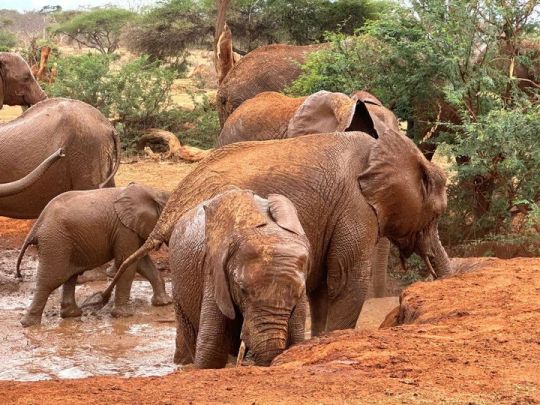
Preserving Tarangire’s Ecological Treasure
As visitors traverse the remarkable landscapes of Tarangire, it is essential to remember the importance of responsible tourism and conservation. Tanzania’s commitment to protecting its natural heritage allows future generations to experience the splendor of Tarangire and its diverse inhabitants.
Tanzania Safari one day Tarangire Tour
A 1-day safari journey through Tarangire National Park in Tanzania is an exhilarating experience that unveils the breathtaking landscapes and remarkable biodiversity of this East African gem. From the iconic acacia woodlands and ancient baobabs to the majestic African elephants and thrilling predator-prey dynamics, every moment in Tarangire is a reminder of the raw beauty and grandeur of the natural world. As travelers depart the park, they carry with them memories that will forever be etched in their hearts, inspiring a lifelong passion for wildlife and conservation. Tarangire stands as a testament to Tanzania’s commitment to preserving its ecological treasure, inviting visitors to connect with nature and protect this invaluable heritage for generations to come.
Visit for an adventure of a lifetime with Victor Tours and Safaris’ One-Day Tarangire Safari in Tanzania! Experience the breathtaking landscapes and witness the diverse wildlife of Tarangire National Park in just one day. Marvel at the majestic African elephants, spot the iconic baobab trees, and be enthralled by the thrilling predator-prey dynamics. Our expert guides ensure an exhilarating and safe journey through this East African gem. Don’t miss this incredible opportunity to immerse yourself in Tanzania’s natural wonders.
Book your Tarangire Safari with Victor Tours and Safaris today!
1 note
·
View note
Text
3 Days Tanzania Sharing /Private Safari to Serengeti National Park & Ngorongoro Crater

Create awesome memories by joining this three-day big five Tanzania safari through the heart of the popular northern circuit parks. our big five Tanzania safaris are specially designated to get you through two of our favorite parks, the majestic land of Serengeti, and thereafter head to Ngorongoro crater which boasts as the world’s largest caldera and the garden of Eden in Africa. book with Africa natural tours this perfect big five Tanzania safari and get a chance to spot all the big five (elephant, black rhino, lion. leopard, African buffalo) and a good number of other animals such as zebras, antelopes, wildebeest, and birdlife such as the ostrich, kori bustard, rufous -tailed weaver, grey -breast spurfowl and southern ground hornbill. This safari package is best for those who have time in Tanzania and wants to combine the astonishing game viewing, with the magnificent scenery around the parks. 3 Days Serengeti
In this famous safari, you will discover two of Africa's 7 natural wonders. Watch the breathtaking wildebeest migration at Serengeti and spot one of the rare rhinos in Ngorongoro Crater. On this safari, you'll revel in an African journey past your wildest dreams.
Day 1: Arusha to Serengeti National Park
after very early breakfast we will drive to central Serengeti also known as the sooner area; the area is the most famous in Serengeti and harbors diverse wildlife compared to the other parts of Serengeti, animals like hippo, waterbuck, impala, elephant, giraffe, and baboon are widely spread here. The area also attracts predators like lions, hyenas, leopards, and cheetah; this is because of the good number of prey that resides in the area. Your professional Africa natural tours guide will take you to all the best spots that are teemed with animals. While game viewing you will enjoy the mesmerizing sight of the wild plains of Serengeti, dinner, and overnight will be offered in your accommodation of choice in central Serengeti.
Day 2: Serengeti National Park to Ngorongoro Crater
After breakfast, you will start your early morning game drive in Serengeti national park whilst enjoying the beautiful sunrise and astonishing wild plains of Serengeti which makes wildlife viewing easy. Animals like lions, zebras, wildebeests, cheetahs, hippos, and many more are easily spotted. After lunch, you will start your driving to Ngorongoro while gaming en route on the way. Dinner and overnight will be offered in your choice of accommodation around the crater rim. 3 Days Serengeti
Day 3: Ngorongoro Crater to Arusha
An early breakfast will be offered at your respective camp /lodge and we will descend to the crater for a full day of game viewing in the world’s largest caldera that has astonishing scenery with a very high concentration of animals even the endangered black rhino. The land is home to many elephants so keep your eyes open to see this large mammal. Ngorongoro crater has a high number of animals, 15,000 wildebeest, 9000 zebras, 400 hyenas, about 120 lions, and around 50 highly endangered species of black rhino. The crater has a good number of birds which include, the augur buzzard, rufous–tailed weaver, fan-tailed widowbird, and anteater chat. The water sources in the crater may be one of the reasons the animals are glued to the area. After a long day of game viewing, we will retire to Moshi/ Arusha for dinner and a night’s rest at your hotel. End of tour.
Included
General
Transport (4x4 Land Cruiser) with open roof
Park fees
Campsites / Lodge
Professional English speaking safari guide and chef
Breakfast; Lunches; dinner
1,5 bottles of water per day
Not-Included
Flights (International & Domestics)
Travel insurance & Medical insurance
Visas
Personal items
Tips for safari guide & chef
Additional Park fees
0 notes
Text
Bucorvus
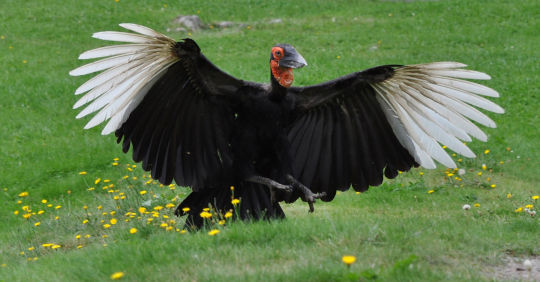
Southern Ground Hornbill by Neil McIntosh, CC BY 2.0
Etymology: Hornbill Crow
First Described By: Lesson, 1830
Classification: Dinosauromorpha, Dinosauriformes, Dracohors, Dinosauria, Saurischia, Eusaurischia, Theropoda, Neotheropoda, Averostra, Tetanurae, Orionides, Avetheropoda, Coelurosauria, Tyrannoraptora, Maniraptoromorpha, Maniraptoriformes, Maniraptora, Pennaraptora, Paraves, Eumaniraptora, Averaptora, Avialae, Euavialae, Avebrevicauda, Pygostaylia, Ornithothoraces, Euornithes, Ornithuromorpha, Ornithurae, Neornithes, Neognathae, Neoaves, Inopinaves, Telluraves, Afroaves, Coraciimorphae, Cavitaves, Eucavitaves, Picocoraciae, Bucerotiformes, Buceroti, Bucorvidae
Referred Species: B. brailloni, B. leadbeateri (Southern Ground Hornbill), B. abyssinicus (Abyssinian/Northern Ground Hornbill)
Status: Extinct - Extant, Vulnerable
Time and Place: From about 12 million years ago, in the Serravallian of the Miocene, through today


Ground Hornbills are known from across the entire African continent

Physical Description: Ground Hornbills are truly impressive living dinosaurs, large in body and bulky in form. They can reach up to 100 centimeters in length, weighing as much as 6 kilograms. They are black over most of their bodies (leading to their being named for crows and ravens, which they are not closely related to at all), with grey legs and grey bills. They also have grey crests on the tops of their heads. Their heads feature bright coloration which is distinguished from the rest of the body - red patches, blue patches, yellow bits, and wattles, which vary from species to species. The undersides of their wings are white, and they have short and thin tails. Called hornbills for their very large, pointed beaks, these bills make up a major chunk of their heads. They also, interestingly enough, have eyelashes on their eyes to aid in protecting them. The juveniles are somewhat brown, and they become more black in color as they age.
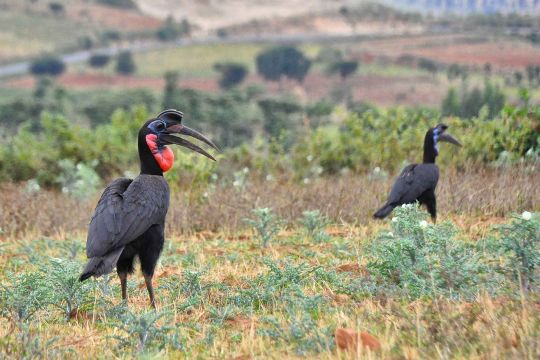
Northern Ground Hornbills by Rod Waddington, CC BY-SA 2.0
Diet: Ground Hornbills primarily feed upon arthropods such as insects, spiders, and scorpions. They also feed upon other invertebrates like snails, and larger prey such as snakes, lizards, small mammals, and carrion. Though they have been recorded feeding upon berries, they are primarily carnivorous.
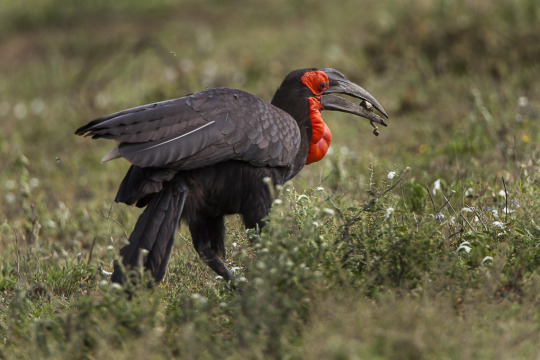
Southern Ground Hornbill by Francesco Veronesi, CC BY-SA 2.0
Behavior: Ground Hornbills are extremely fascinating creatures, able to fly but spending most of their time on the ground searching for sources of food. They will move slowly and carefully, searching around for prey that then is picked up with their large bill, very carefully and in a picky fashion from the ground. They forage in small groups - with a mate, or with their offspring. They rarely gather in large groups, usually only when food is especially abundant. They’ll even dig into the ground or poop looking for food. When large prey is found, groups will gather and attack it together, dismembering it as a team. These are extremely vocal birds, making low-pitched hoots at each other often at two different pitches. They will make softer hoots when snuggling with each other, and deep alarm grunts. They are often known to call for long periods of time. They do not migrate, but do wander about; juveniles will stay where their parents lived for many years.
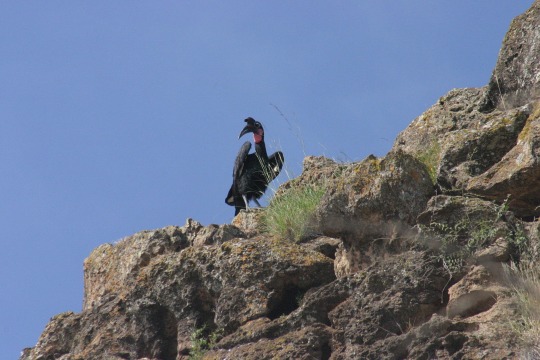
Northern Ground Hornbill by Sakari A. Maaranen, CC BY 3.0
The Ground Hornbills are cooperative breeders - the dominant pair will be assisted by juvenile and younger adult helpers, all defending the nesting territory fiercely. Males will prepare their nests in large tree cavities, sometimes in rock holes or baskets - they will line the hole with dry leaves, and not seal the entrance. Two to three eggs are laid and incubated for two months by the dominant female of the group. Upon hatching, the group members will feed the babies together, but usually the second or third eggs don’t survive - either the eggs don’t hatch, or the chicks starve to death. The chicks stay in the nest for three more months, and the juveniles stick with their families for a little while after hatching. They tend to reach sexual maturity between six and seven, but they don’t usually breed for the first time until later. They also tend to breed only once every three years - a rarity for birds. The birds can live for a very long time - in captivity, they’ve been seen living for up to 40 years.
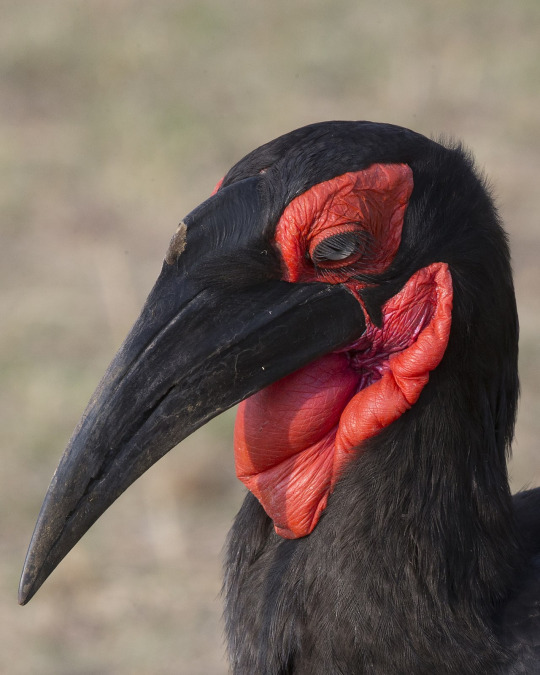
Southern Ground Hornbill by Lip Kee, CC BY-SA 2.0
Ecosystem: Ground Hornbills live in a variety of habitats, across woodland and savanna, as well as grassland patches. The Southern Ground Hornbills live in more moist habitats than the Northern Ground Hornbills. They are often fed upon by large carnivores such as leopards, and can be a host for a wide variety of parasites and diseases.

Northern Ground Hornbill by Bernard Dupont, CC BY-SA 2.0
Other: All living Ground Hornbills are recorded as being vulnerable to extinction at this time. Despite being extremely widespread, they are sparse across their range. This sparseness makes it harder for them to find others of their species and mate with them. They are often hunted and killed, or even murdered as a bringer of bad luck in some cultures. Ground Hornbills also break window panes and are killed for that, in addition to being killed for being a harbinger of drought. Habitat loss also greatly contributes to their decline in population. They do live in several national parks, and there are conservation efforts to aid in its reproduction, using the abandoned eggs to raise more of the birds. Reintroduction, however, is more difficult than anticipated.
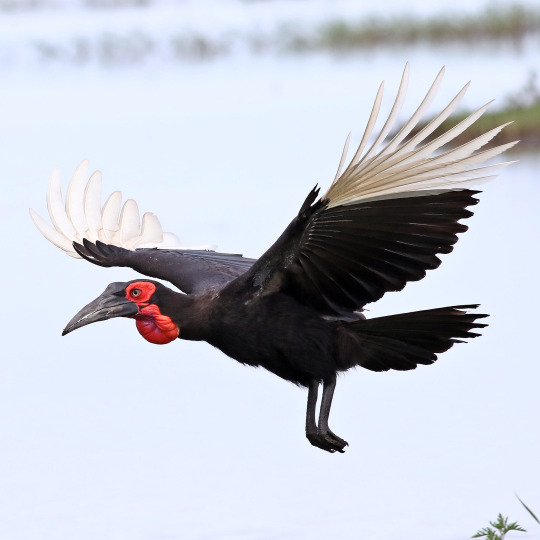
Southern Ground Hornbill by Derek Keats, CC BY 2.0
Species Differences: The Northern Ground-Hornbill is known from Central Africa, and features blue patches on its face with a yellow bit in the front. Males have red additions to their throat wattles. The Southern Ground-Hornbill, on the other hand, is all red, with no yellow or blue to be found. They are also found in southern Africa. In addition to all of this, the Northern Ground-Hornbill is somewhat lighter in weight than the Southern Ground-Hornbill. The extinct species, B. brailloni, was from much more north - in Morocco - and was much older, as well as a little smaller, than its living relatives.

Northern Ground Hornbill by Noel Reynolds, CC BY 2.0
~ By Meig Dickson
Sources under the Cut
Gill, Frank; Donsker, David, eds. (2019). "Mousebirds, Cuckoo Roller, trogons, hoopoes, hornbills". World Bird List Version 9.2. International Ornithologists' Union. Retrieved 23 July 2019.
Gonzalez, J.-C.T.; Sheldon, B.C.; Collar, N.J.; Tobias, J.A. (2013). "A comprehensive molecular phylogeny for the hornbills (Aves: Bucerotidae)". Molecular Phylogenetics and Evolution. 67 (2): 468–483.
Jobling, James A. (2010). The Helm Dictionary of Scientific Bird Names. London: Christopher Helm. p. 80.
Kemp, A. C. 1995. The Hornbills. Oxford University Press, Oxford.
Kemp, A.C. & Boesman, P. (2019). Northern Ground-hornbill (Bucorvus abyssinicus). In: del Hoyo, J., Elliott, A., Sargatal, J., Christie, D.A. & de Juana, E. (eds.). Handbook of the Birds of the World Alive. Lynx Edicions, Barcelona.
Kemp, A.C. & Boesman, P. (2019). Southern Ground-hornbill (Bucorvus leadbeateri). In: del Hoyo, J., Elliott, A., Sargatal, J., Christie, D.A. & de Juana, E. (eds.). Handbook of the Birds of the World Alive. Lynx Edicions, Barcelona.
Kinnaird Margaret F. and O‘Brien, Timothy G.; The Ecology and Conservation of Asian Hornbills: Farmers of the Forest; pp. 20-23.
Lesson, René (1830). Traité d'Ornithologie, ou Tableau Méthodique (in French). Paris: F.G. Levrault. p. 256
Peters, James Lee, ed. (1945). Check-list of Birds of the World. Volume 5. Cambridge, Massachusetts: Harvard University Press. p. 272.
Skutch; Alexander Frank (author) and Gardner, Dana (illustrator) Helpers at birds' nests : a worldwide survey of cooperative breeding and related behavior pp. 69-71. Published 1987 by University of Iowa Press.
Wasser, D. E. and Sherman, P.W.; “Avian longevities and their interpretation under evolutionary theories of senescence” in Journal of Zoology 2 November 2009
#Bucorvus#Ground Hornbill#Bird#Dinosaur#Hornbill#Birblr#Factfile#Bucorvus brailloni#Bucorvus leadbeateri#Bucorvus abyssinicus#Southern Ground Hornbill#Palaeoblr#Abyssinian Ground Hornbill#Northern Ground Hornbill#Afroavian#Terrestrial Tuesday#Carnivore#Africa#Quaternary#Neogene#paleontology#prehistory#prehistoric life#dinosaurs#biology#a dinosaur a day#a-dinosaur-a-day#dinosaur of the day#dinosaur-of-the-day#science
120 notes
·
View notes
Photo




Northern Ground Hornbill (female), Bucorvus abyssinicus
6 notes
·
View notes
Photo






A Mighty-billed Feathursday
This week we bring you wood engravings of some supremely-beaked toucans and hornbills from Part 2, Volume 2 of Brehms Thierleben (1882). Most of these illustrations were drawn by German nature artist Robert Kretschmer and engraved by Richard Illner, while two (the Black-necked Aracari and the Abyssinian Ground Hornbill ) were drawn by the noted German wildlife artist Gustav Mützel and engraved by Karl Jahrmargt.
While both toucans and hornbills sport magnificent, outsized, and often colorful beaks, hornbills are an Old World group unrelated to the toucans of the New World. While the stronghold of the toucans is in Central and South America, hornbills are found in sub-Saharan Africa and Asia, with a single species in New Guinea. Hornbills make up the Bucerotidae family in the order Bucerotiformes and are related to hoopoes. Toucans form the Ramphastidae family, in the order Piciformes and are more related to woodpeckers. Shown here from top to bottom:
1.) Common Toucan (Ramphastos toco).
2.) Black-necked Aracari (Pteroglossus aracari).
3.) Northern Red-billed Hornbill (Tockus erythrorhynchus).
4.) Blyth's Hornbill (Rhyticeros plicatus).
5.) Abyssinian Ground Hornbill (Bucorvus abyssinicus).
6.) Great Hornbill (Buceros bicornis).
Find out more about Brehms Thierleben.
View more posts from Brehms Thierleben.
View more Feathursday posts.
#Feathursday#toucans#hornbills#Common Toucan#Black-necked Aracari#Northern Red-billed Hornbill#Blyth's Hornbill#Abyssinian Ground Hornbill#Great Hornbill#Brehms Thierleben#wood engravings#Robert Kretschmer#Richard Illner#Gustav Mützel#Karl Jahrmargt#Bucerotiformes#Bucerotidae#Piciformes#Ramphastidae#birds#birbs!
75 notes
·
View notes
Text








916 IS SPECIAL FOR ME
I was born in Kuching, Sarawak in 1947, then a British colony on the northern backbone of Borneo facing the South China Sea.
On a significant day in 916
or 16 September 1963, Sarawak gained independence and became an eastern state of Malaysia, about 58 years ago.
I love my hometown Kuching where I grew up; I love my school; I love Sarawak; I love Sarawakians. We are a kindred spirit.
In 1967, I went to study at a university overseas. I met a girl there, my dental classmate, who is now my loving wife of 48 years. We have two sons and one grandson. And I became a citizen of that country.
O fair land of Sarawak ... my home ... my school ... a homeland I visited often, nowadays much like the childhood home I had since abandoned ...
This is my tribute to my homeland:
FAREWELL TO HARMONY
O fair land of bliss, birth place that helped groom my fragile youth
Of tales better remembered than sermons on unspoken truth
Where poor emigrants had mingled well with the hornbills and the natives.
Alas! From afar, rich explorers arrived to rule and lord over our lives,
Plundering fields and habitat, cursing the blessed harmony.
Wounded, the sacred ground bled and moaned in loathsome agony,
Paving the way for the rise of a brand new breed
To overthrow this folly of pure foreign greed.
But history shall repeat itself, sadly I must say,
For the rule is no better today than yesterday.
Rivers of greed, bribery and deceit still meander and burrow;
Bends and hidden tunnels have replaced the straight and narrow.
Prejudice and Power now possess the upper hand;
Fairness and Equality have vanished from the land.
Remembrance sweeps my mind to console my heaving chest
Fond memories freeze my grief, comfort and put my pain to rest.
Near yonder bend on a rocky road stood the sturdy devoted school
That taught the virtues of saints and values of man-made rules.
Discipline and obligation had not known exception;
Truants and the disobedient must bear the rod of correction.
Constant prayer and hard work, its motto shall remain
Unchanged, to ascend the rugged path towards future gain.
Sports and athletics had carved endurance with sharpened strength,
To hurdle obstacles, to conquer heights, by width and by length.
It was the standard then and pray today is still the practice
To endow in hope with fortitude, be one learned or apprentice.
Yet be not like the charging train but a constant contemplative,
Never to plunge head-on to desire but be wisely imaginative.
I had been there, unnoticed, apprehensive but not fearful.
In silence did I perceive the true lesson and learn to be grateful
To cherish the abounding grace and blessing I now find,
Greying graciously in my twilight years in spirit, body and mind.
©Johnny J P Lee
09 April 2021
Photos Credit J. P. Lee
#instruth#instruthpoems#instruthpoetry#instruthstories#instruthsongs#instruthliterature#instruth novels#instruth writings#instruth spirituality#instruth literary contributions#warxpunkxmonk#frankl410#acrobat888#poetryportal
21 notes
·
View notes
Text
A World of Dinosauroids
C. M. Kosemen with Simon Roy
My post on Simon Roy’s “Dinosauroids” is one of the most reblogged things on this blog. I love the concept because it rewrites the cosmic tragedy of the K-T Mass Extinction Event, resurrecting dinosaurs and projecting their continued evolution in ancient world that is alien but also eerily resonant. Recently Simon turned me onto The-Master-Post-on-All-Things-Dinosauroid on his long-time collaborator, C. M. Kosemen’s, site. The following post has been transcribed from C. M. Kosemen’s blog and formatted for Tumblr with @simon-roy‘s blessing.
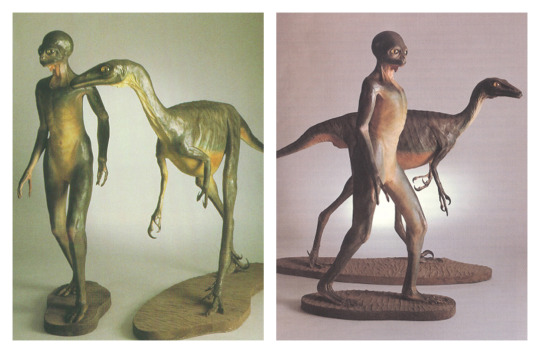
There are two highly-popular, vexing questions about dinosaurs: What would the world look like if these strange and majestic animals had not gone extinct? And, would they ever evolve into intelligent species comparable to humans? In 1982, palaeontologist Dale Russell, after observing “… a general trend toward larger relative brain size in terrestrial vertebrates through geologic time, and the energetic efficiency of an upright posture in slow-moving, bipedal animals”, postulated the Dinosauroid, a humanoid, erect-gaited sophont which may have evolved from Troodon-like dinosaurs had the end-Cretaceous extinction not occurred.

This question occupied the minds of yours truly (seen here on the right), and world-building comic genius Simon Roy (on the left), as well. We were unconvinced by Russell’s Dinosauroid. We thought that an erect, humanoid sophont was too prejudiced towards humans to be realistic. We were instead inspired by zoologist Darren Naish’s writings on the evolution of intelligent, bird-like dinosaurs: “No, post-Cretaceous maniraptorans wouldn’t end up looking like scaly tridactyl plantigrade humanoids with erect tailless bodies. They would be decked out with feathers and brightly coloured skin ornaments; have nice normal horizontal bodies and digitigrade feet; long, hard, powerful jaws; stride around on the savannah kicking the shit out of little mammals; and in the evenings they would stand together in the trees, booming out a duet of du du du-du, a deep noise that would reverberate for miles around…”
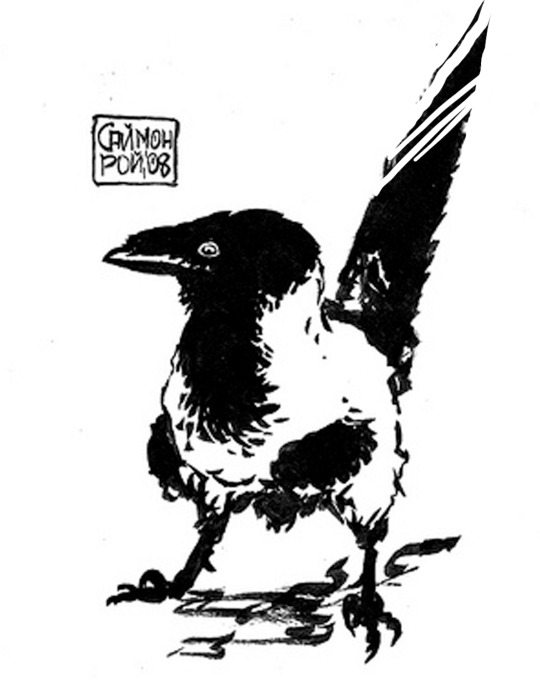
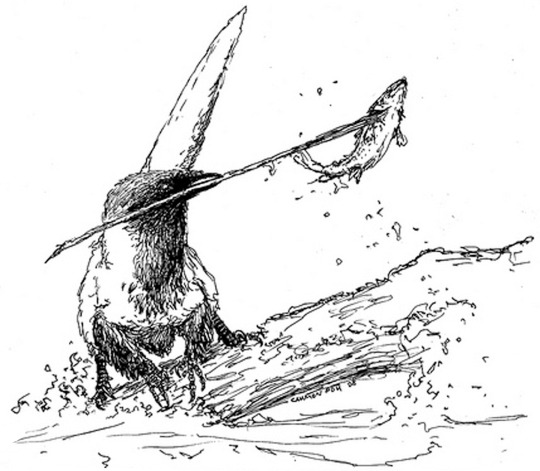
Towards the end of the ‘00s, Simon Roy and I independently began to develop our concepts for bird-like intelligent dinosaurs. Inspired by the ravens he saw around his Canadian home, Simon drew the corvid-like dinosauroids seen above.
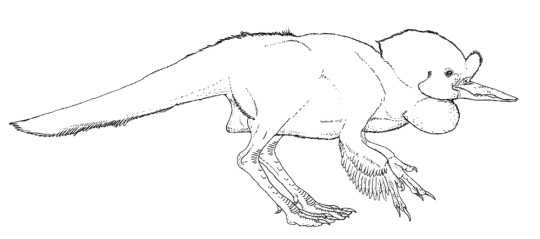
I, in turn, was inspired by ground hornbills, parrots, certain dinosaurs and corvids, and came up with the speculative organism seen above. I named it Avisapiens saurotheos.
Simon and I soon got in touch with each other; and started developing a world and a storyline for our dinosauroids. Our collaborative efforts continued, on-and-off, until the mid-2010s. Our aim was to develop the Dinosauroids story into an illustrated story-book, which we naively hoped to sell to a major sci-fi publisher. But we soon realised that we enjoyed world-building more than writing a story, or putting a book together. We kept bouncing concepts back and forth, but never had a chance to publish them, until now. Most of the body of work you see on this page was drawn by Simon, based on ideas we created together. I also contributed some of the “cave drawings” and certain creature illustrations. This is the first time the totality of our Dinosauroids-universe works has been displayed online.
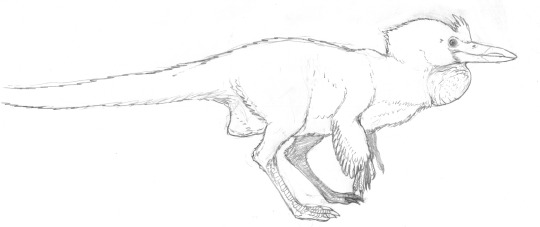
Simon and I refined the design of my original Avisapiens dinosauroid…
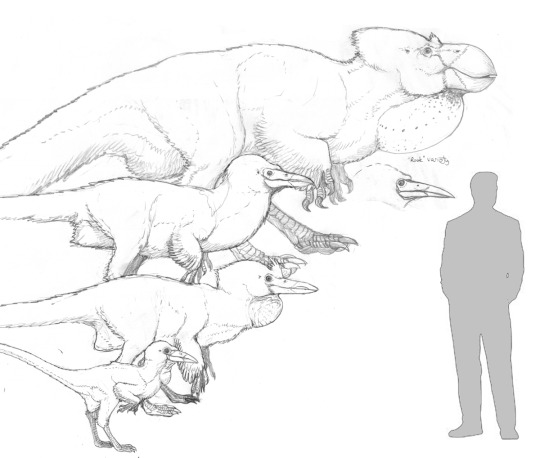
And created a few more sentient races to accompany them. There was one more, slightly-crow-like species of Avisapiens (a continuation of Simon’s corvid dinosauroids - Avisapiens tataricus). These two species were joined by a variety of “forest giants” (Gigantosapiens borealis), and a race of pygmies (Avisapiens minimus).
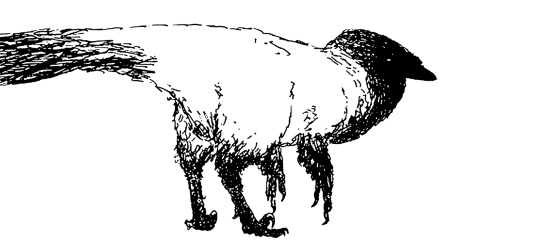
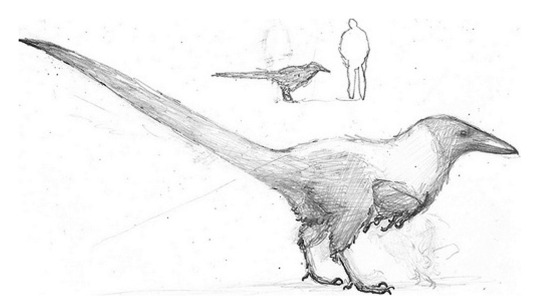

Simon’s refined studies of corvid-like, and pygmy dinosauroids.
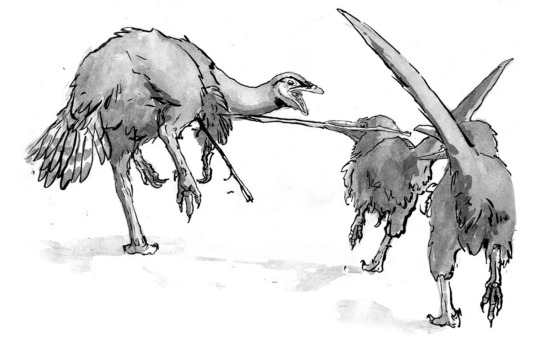
We also designed an extensive selection of animals around our dinosauroids. We predicted that even without the K/T mass extinction, dinosaurs and other animals would have kept on evolving, and many “familiar” groups of dinosaurs would have gone extinct. We thus designed a world where the majority of surviving dinosaurs were the descendants of “maniraptoran” groups; birds, deinonychosaur (“raptor”) dinosaurs, troodonts, oviraptors and therizinosaurs. Here, you can see two boreal dinosauroids using mouth-spears to hunt herbivorous troodont quarry.
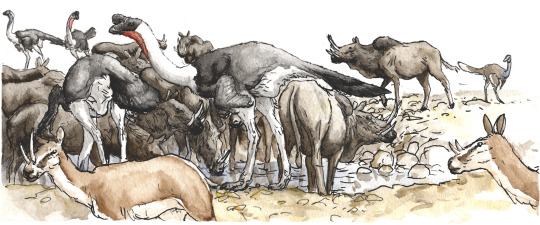
We also did not want this world to be devoid of mammals. Even during the age of dinosaurs, certain mammals evolved into large and sophisticated forms. We envisioned a world where parallel groups of mammals, similar to, but phylogenetically distinct from today’s forms, co-evolved alongside the dinosaurs during their continued reign. The scene above shows an Eurasian water-hole crowded with two species of ornithomimid herbivores (Rugocursor, left-centre; and Cyanogularia, far right); alongside robust (Afrotuberculocamelus) and gracile (Odontocervoides) species of herbivorous mammals which, for the lack of a better term, we decided to name “supermaras”.

A series of studies showing the evolution of supermaras from rodent-like multituberculate mammals. The species depicted here is Ceratomegamys.

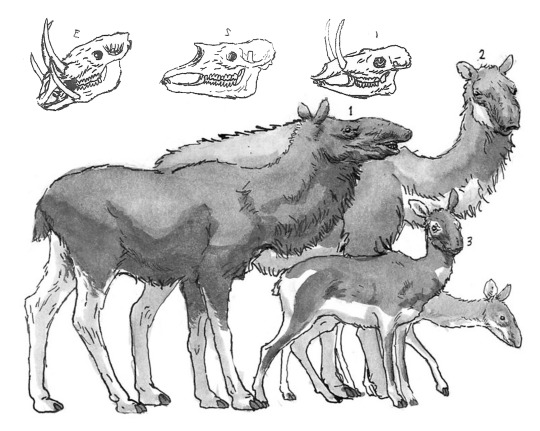
The full diversity of cursorial “supermaras”, from left to right: The burly, tusked Odontobovis; the superficially-camel-like Tuberculocamelus; the gazelle-like Odontocervoides; the trunked, moose-like Pseudalces; and the two related forms - the big, desert-dwelling Macropseudalces; and one of the many deer-like Cervopseudalces species.


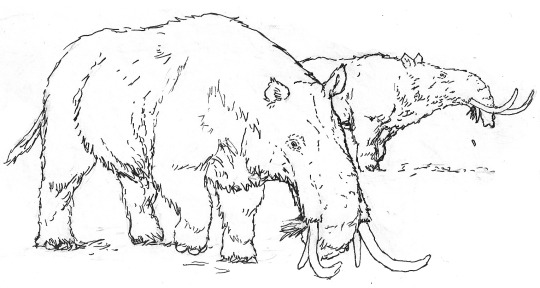
Studies of Megatapirus, large, superficially-elephant-like mammals that live in far-northern climates.


We also derived a variety of mammalian carnivores, mostly from marsupial stock. Through the honing forces of evolution, we imagined some would look very similar to the canid predators we have in the present day - the actual difference would only be in their internal and reproductive anatomies. Above, clockwise: The large, badger-like Mephitursoides; the extremely dog-like Pseudokynos; the hyena-like Krokutadasyurus.

Some marsupial predators diverged from the mammalian body-plan, and evolved into forms roughly converging with the predatory dinosaurs. The raptorial, meat-eating kangaroo-equivalent Theropodoktonos and kin are potent predators in South America.
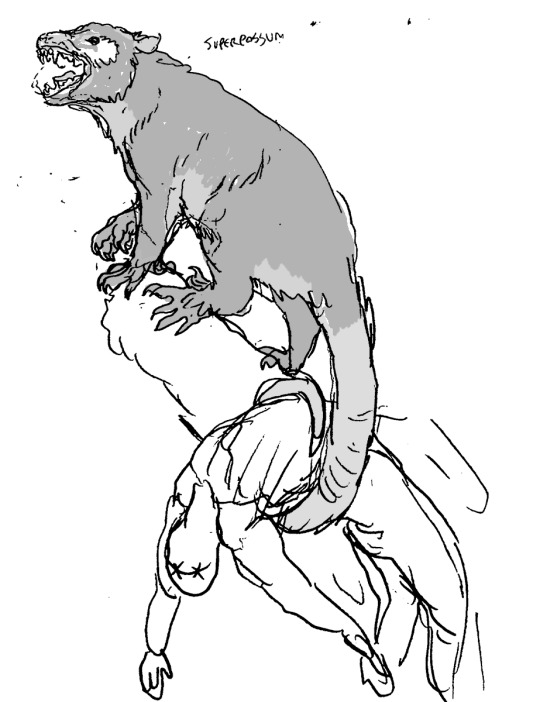

Two more divergent marsupials: The leopard/possum Phobodidelphyoides; and the monkey-like Marsupiolemuris, a social, arboreal form with a potential to evolve intelligence.

We also wanted to have flying reptiles - pterosaurs - still alive and kicking in our world. These extraordinary animals were already in decline by the time dinosaurs became extinct. So we relegated them to only a few roles, comparable to storks and other large water-birds alive today. Above is a flock of Diluvipterus; large, filter-feeding pterosaurs. Also note the solitary duck flying on the upper-left corner.
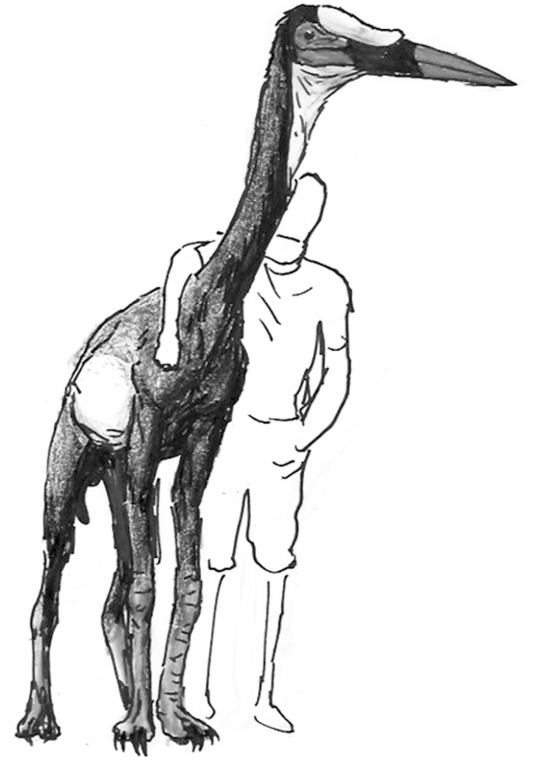
Another, flightless pterosaur, Cygnotherium, from the islands that now make up New Zealand.


A more unusual group are the avisuchians, descendants of maniraptoran dinosaurs that secondarily converged on the aquatic bodyplans of spinosaurs (which are now extinct in this timeline). Most resembled the short-tailed forms, Pisciraptor and Brachyornithoides seen above. These goose-to-dog-sized animals inhabit rivers and lakes, and occupied a niche comparable to otters today.

There were also long-tailed Avisuchians such as the Natatoraptor seen above. These animals inhabit open waters, and nested in estuaries and beaches.

A contemporary scene from Eurasia shows commensal life between mammals and dinosaurs. Two Pseudalces browse peacefully alongside two kinds of large ornithominids, Archganseria and Brontonyx. A tiny, heron-like troodont, Anatolocursor, can be seen between them, looking for small animals flushed out by the large herbivores’ movements.

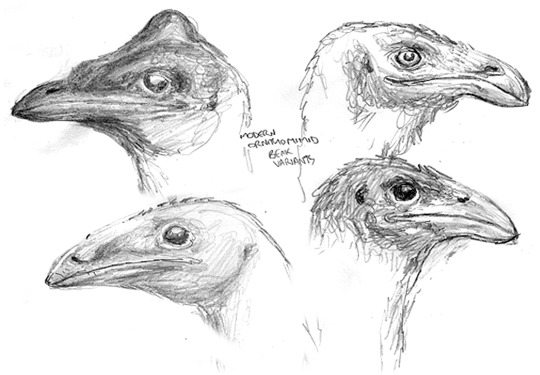
Nevertheless, despite co-existing with large mammals, dinosaurs are more diverse on this world. Herbivorous dinosaurs, such as these derived ornithomimids, constitute a large part of dinosaurian diversity. Above left are studies of Ganseria, a common, medium-sized browser. Above right, clockwise from the top right, are portraits of Ukkuloganser, another medium-sized browser; Nyctodromon, a nocturnal digger; Adzuganser, a small omnivore; and Pyramidoganser, a crested form native to the Nile Delta.

A scaled study of Brontonyx, a heavyweight ornithomimid herbivore.

Portraits of many cursorial dinosaurs from across Eurasia:
1- Leptoganseria, a mountain-dwelling ornithomimid browser found on the mountains of what is now the Caucaus.
2- Ikiridectes, a troodont that mostly hunts small digging mammals.
3- Aktardektes, a small ornithomimid that has specialised for cracking hard-shelled nuts.
4- The gracile, juvenile variant of Brontonyx, (6) which occupies a completely-different ecological niche as a generalist omnivore.
5- Rugocursor, a widespread, broad-beaked ornithomimid with many species, common across North Africa and Eurasia.
6- The adult form of Brontonyx, a gigantic ornithomimid that feeds on trees, and defends itself with heavy claws.
7- A vulture-like Cynornithoides, an extremely bird-like troodont, a frequent commensal of Avisapiens and related intelligent species.

A variety of Rugocursor, a mostly-herbivorous ornithomimid with adaptations for running.
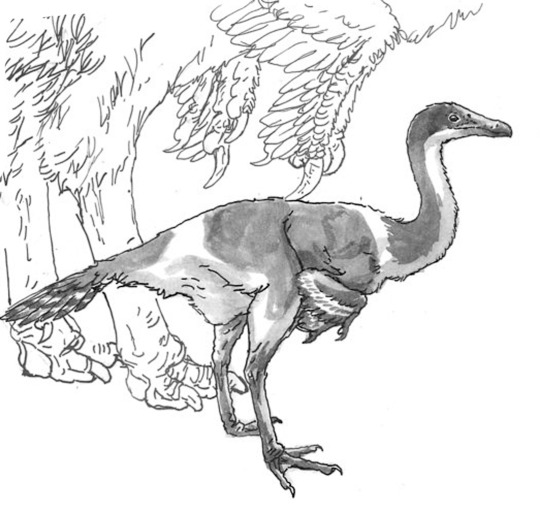
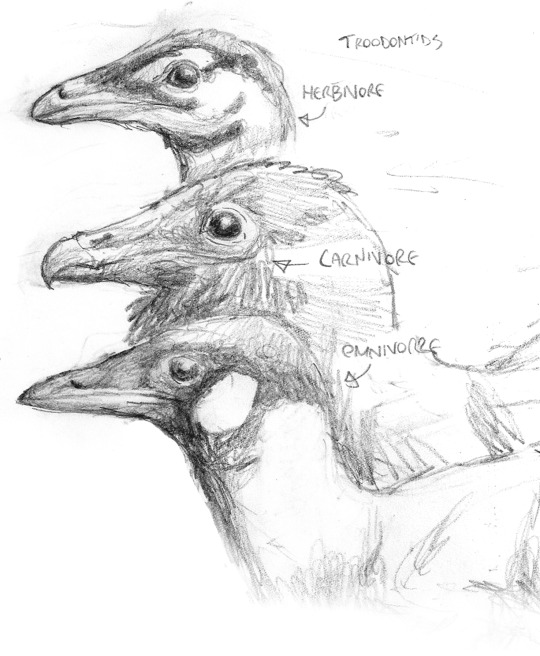
Various troodonts, small-bodied, sometimes very bird-like omnivorous dinosaurs, distantly related to the Avisapiens lineage. Left, shaded study of Variocursor, a common, heron-sized, striding predator on small animals. Right, from top to bottom; Vuuria, a herbivorous form common across Eurasia; Boreocursor, a cold-climate predator, related to the Variocursor seen on the left; and Paravuuria, an omnivorous form.


The last descendants of hadrosaurs, the famous “duck-billed dinosaurs”, still roam in South America. The hoofed, sheep-sized Ornimastax seen above left, is a typical example. Australia, as in our world, is home to an unusual radiation of forms whose relations to animals on other continents are not very clear. Brachygullagong, seen above right, is a troodont-like form whose duck-like skull and batteries of grinding cheek teeth have secondarily converged with those of the hadrosaurs.

The largest herbivores on this world are long-necked, scythe-clawed ornithomimid relatives known as avititans. The largest species on Eurasia is Avititan bicolor, seen above in scale with a human figure.
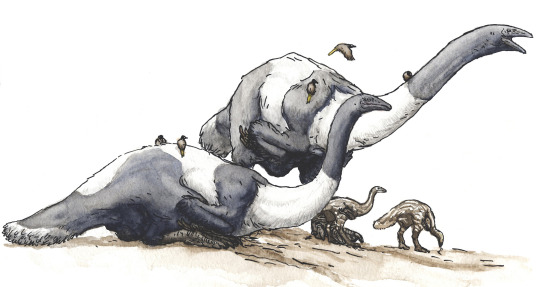
Avititans owe their ecological success to their strong social structures and their care of their young. Here are two Eurasian avititans with their offspring. Yellow-tailed enantiornithine tick-birds, Parasitophagus leucurus, can be seen on their backs.

Oviraptoriformes made up another important clade of dinosaurs in this world.

Descended from bird-like ancestors, various clades of these animals live on as important omnivores, scavengers and even predators in many ecological niches. Above is Eblisornis, a common species found throughout Eurasia.
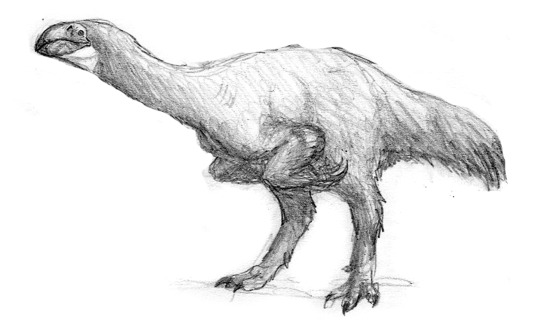
The bull-bird, Bosornithoides erythrops, is the largest and most prominent oviraptoriform on the Eurasian continent. It subsists mostly on plants and fruit, but will eat carrion if given the chance.
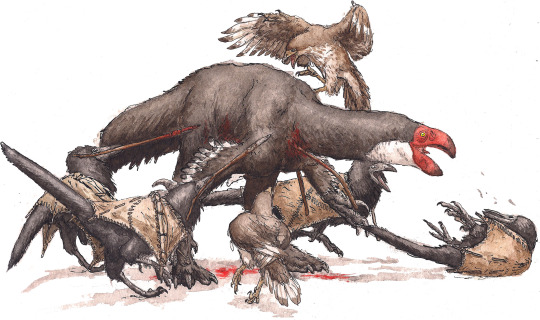
Hunting the wary and dangerous Bosornithoides is an important rite of passage for dinosauroids. The animals require coordination and group-work to bring down, and hunting one is a bonding experience for batches of young-adult nestmates. This ritual not only cements the dinosauroids’ social standing in their tribe, but also bonds the hunters together for the rest of their lives. The four hunters-to-be in this picture are accompanied by a couple of jackal-birds (Cynornithoides), domesticated pets that are almost as smart as the dinosauroids themselves.
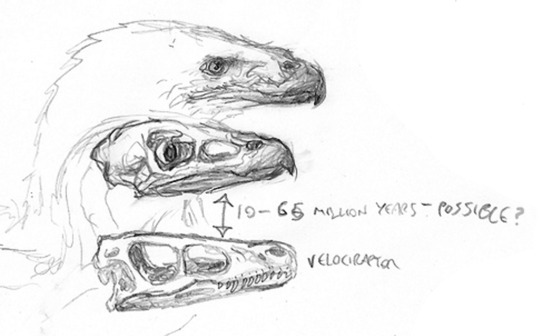
Many dinosaurs dabble in carnivory, but the main predatory niches on this version of Earth, are occupied by a diverse radiation of paradromaeosaurs, descendants of the famous “raptor” dinosaurs and kin. Paradromaeosaurs have diverged considerably from their ancestors. One lineage, known as the rhynchovenators, replaced their teeth with sharp, raptorial beaks.
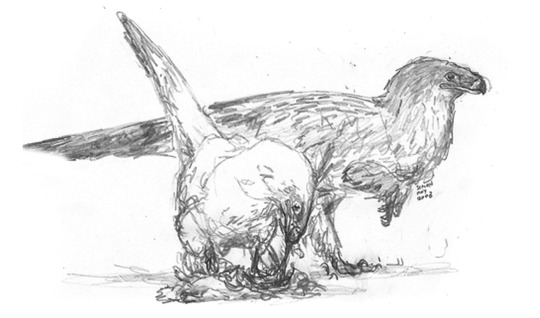
The male and female of the common boreal rhynchovenator, Rhynchovulpes agilis.

A lean-legged Egyptian rhynchovenator, Rhnychovulpes aegypticus, atop a dead multituberculate mammal. The key to rhnychovenators’ success is their added tenacity and stamina. Even a small rhynchovenator can overcome comparatively large prey by continually harassing and chasing it into exhaustion.

The bald-headed Osteophaganax regalis is a common scavenger encountered across the Caucaus Mountains. Its males develop striking, black-and-purple wattles on their faces during spring.
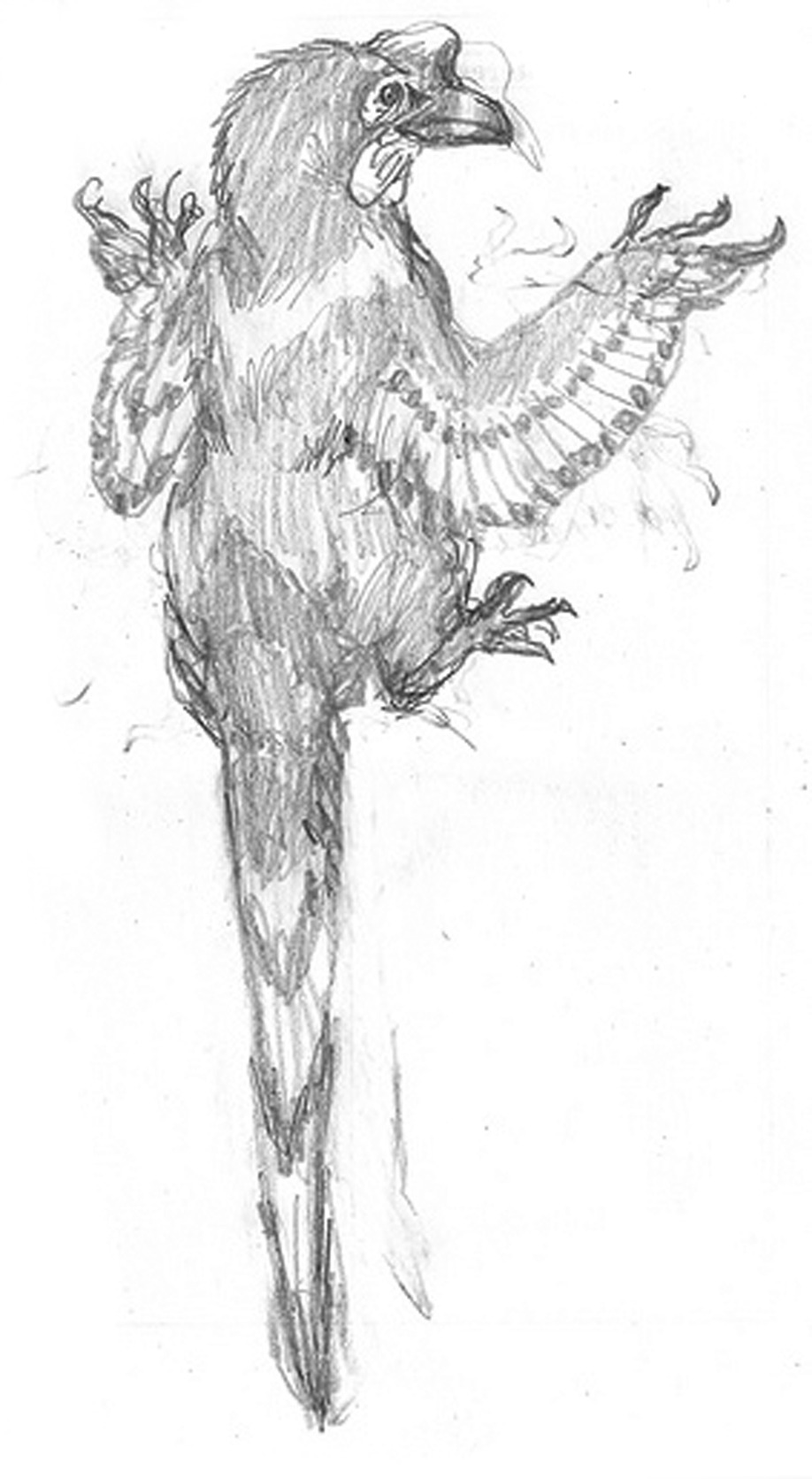

Two more derived troodonts. Left, a tree-dwelling arbosaur, Toucanops dixoni, from one of the diverse and little-understood clades found across the South American continent. Right, the lean, narrow-beaked Halophagus sp. from fossil deposits in what is now China. This group evolved specialisations for marine diving and probably saltwater drinking, before becoming extinct during the Miocene.
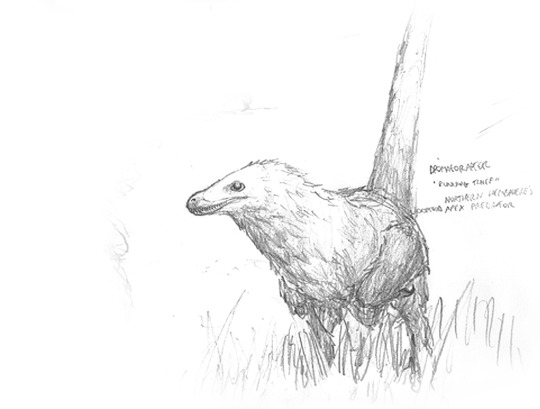
The dominant guild of maniraptoran predators, the tyrannoraptors, evolved from “regular” dromaeosaurs with powerful, biting jaws. Some species living today, such as the Savannahdromeus shown above, are still very similar to the earliest forms. Despite its small size, the smart and social Savannahdromeus are apex predators thanks to their pack-hunting behaviour.

Another basal tyrannoraptor, Pantherdromeus - is a solitary hunter that is common across much of Eurasia. It probably represents a diverse and subtly-variable species complex.

Solitary, basal tyrannoraptors eventually gave rise to the terrifying main-line tyrannoraptors in the last twenty-million years. The evolution of these animals was marked by the reduction of their wings and the enlargement of their legs, and jaws. Their tails developed into stiff and rod-like balancing organs. In some respects, they were the evolutionary echoes of the big-jawed, running tyrannosaurs, which had become extinct earlier on, during this world’s version of the Eocene period. Unlike tyrannosaurs, however, tyrannoraptors had well-developed social behaviours and intelligence; which, when coupled with their fast speed and terrific jaws, turned them into formidable apex predators. Above are the adolescent and mature forms of Metadromodaemon phobetor, a mid-sized hunter found in the Middle East and North Africa.
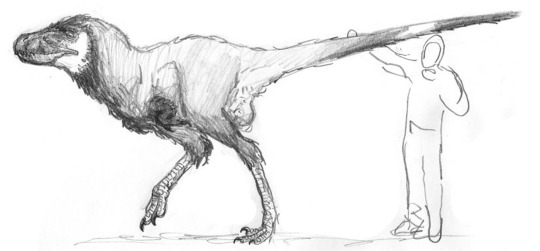
A scaled drawing of Wotandromeus bicolor, the terrifying, large-headed hunter of European forests.
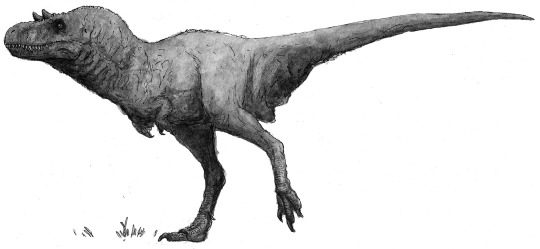
The seven-metre-long Melanorodromeus euceratus - also known by the Dinosauroids as “black thing” - is the largest predator on mainland Eurasia; but even larger forms are reputed to exist in Siberia and North America.

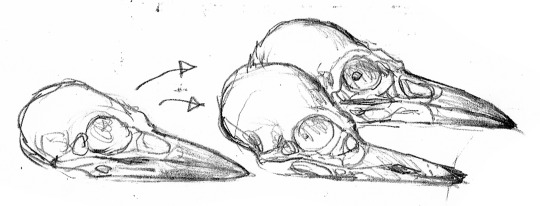
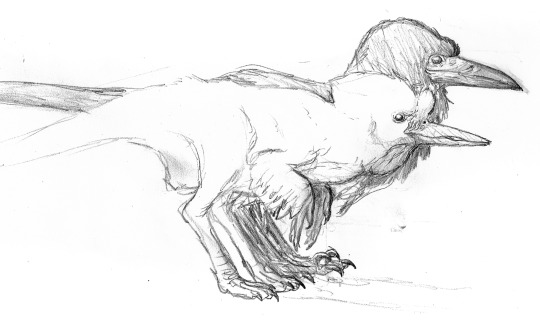
Let us now return to the Dinosauroids, their culture, and art. Above is a brief study illustrating the divergence of the two species of Avisapiens; A. saurotheos and A. tataricus, from ancestral eu-troodontid stock.


Especially A. tataricus shows considerable variation in beak shape, length and colouration. Above, right are the colouration of the Eurasian (top right, bluish-black), and Northeast Siberian (above right, yellowish-brown) races. Above, left shows a spectrum of variation in A. tataricus beaks. The cross-beaked and long, curved beaks occasionally crop up in certain bloodlines, which also have augmented song-memories. These individuals are revered as shamans in certain A. tataricus tribes; or are immediately killed-off as harbingers of doom in others.
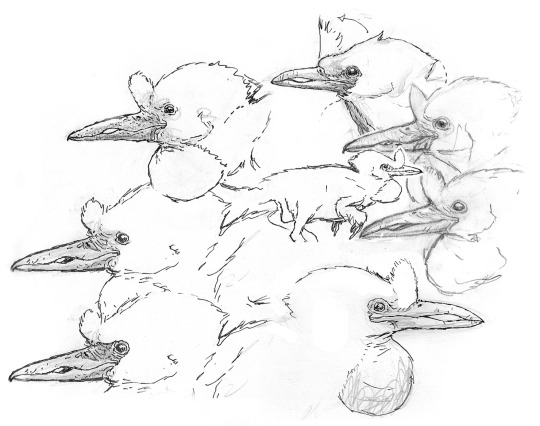
Above, the extensive variation in the head shapes, beak lengths and crests of various races in A. saurotheos. The bottom-right sketch depicts a hybrid individual between A. saurotheos and A. tataricus.

A powerful hunter of A. tataricus, from the Carpathian Mountains, showing a stone axe and bent spear that are characteristically used by this particular tribe.
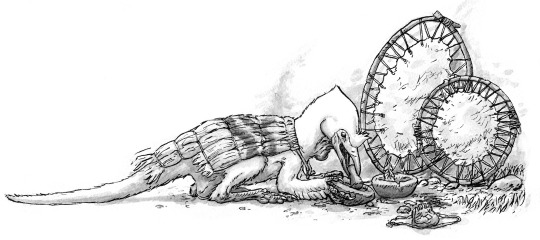
An artist/shaman of one of the settled A. saurotheos tribes living around the Balkans. He paints on animal skins stretched taut across circular frames, and paints using ground-up soil and other pigments, wielding a brush made from a wing-feather. The skin canvas also double as drums.
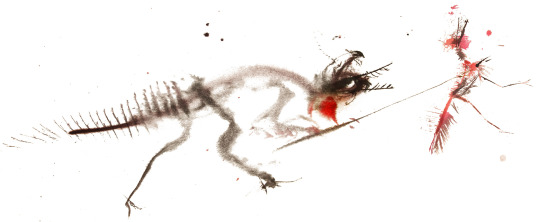
Art is one sure-fire way of identifying an intelligent species. This skin-painting shows a spear-hunter and prey, a painting by the aforementioned shaman.

Painting of a god or hero-figure with red tail feathers.
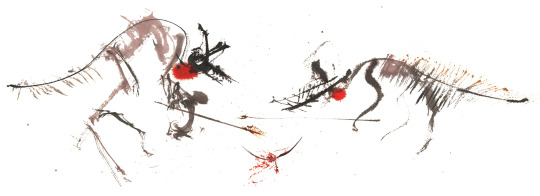
Painting of two shamans divining the future from the entrails of a dead flying animal.
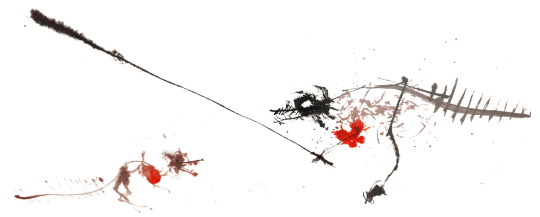
Painting of a hatchling being trained by a village elder.
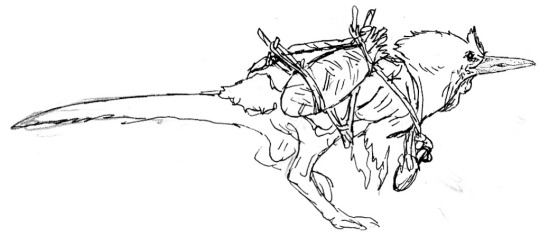

Studies of an A. saurotheos wanderer with a travel harness; and a duo of A. tataricus migrants with a domesticated bull-bird, a relative of the oviraptoriform Bosornithoides mentioned above.
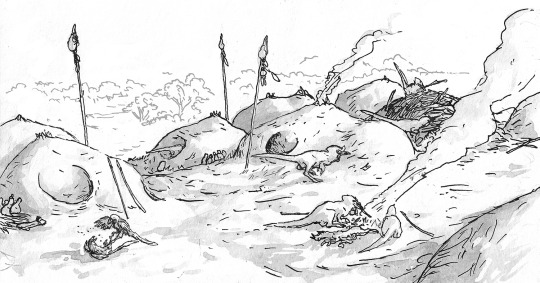
The view from an Avisapiens saurotheos village, showing the species’ characteristic nest-houses, and a pair of semidomesticated Cynornithoides jackal-birds playing in the village square. Note the heads mounted on tall poles, a sign of reverence to the spirits of the departed.
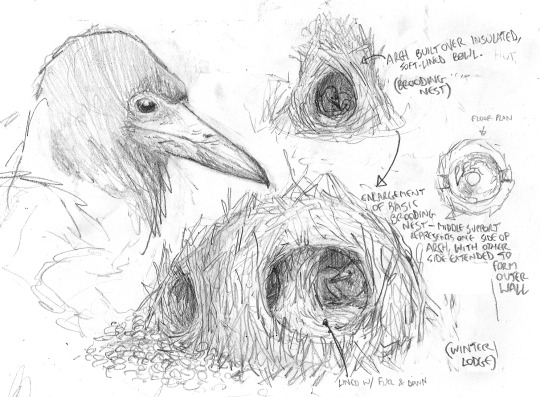
Detail of a brooding nest constructed by Avisapiens tataricus. Most tribes of these species are migrants that range across Eurasia, few build permanent structures.

Sketch of an A. tataricus wearing a travois-like travel harness.

Study of an A. saurotheos wanderer with travel gear.
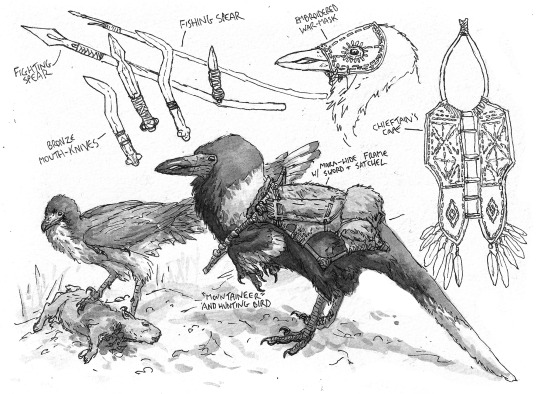
A detailed study of the burly A. tataricus native to the Caucaus Mountains, complete with weapons, travel gear and ornamental cape.

Sketches of war-like A. tataricus tribes native to the Eastern Mediterranean region. These tribes are known for their ferocious (if impractical) war-masks.
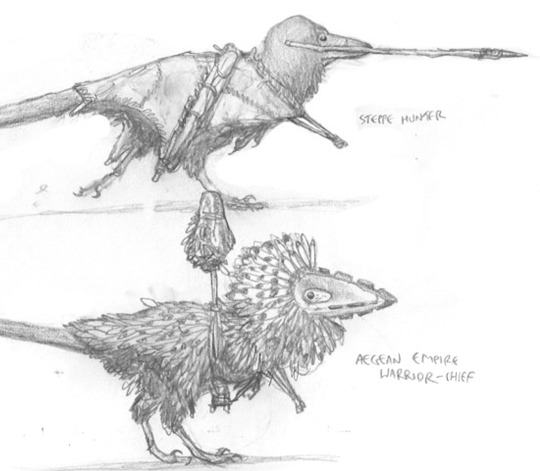
Studies of two different warriors from two different Avisapiens tataricus societies.
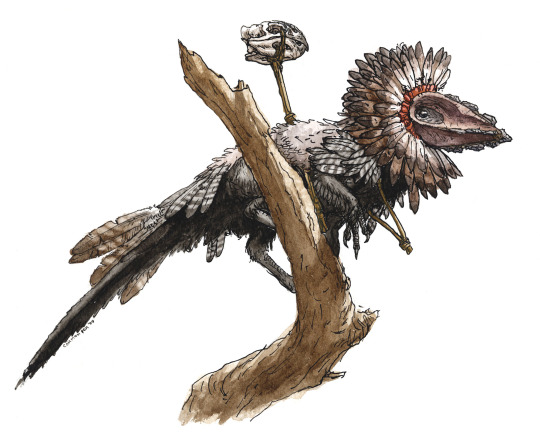
A resplendent A. tataricus warrior from the Levant, wearing an ornate head-dress of feathers, and an obsidian-studded war-mask.

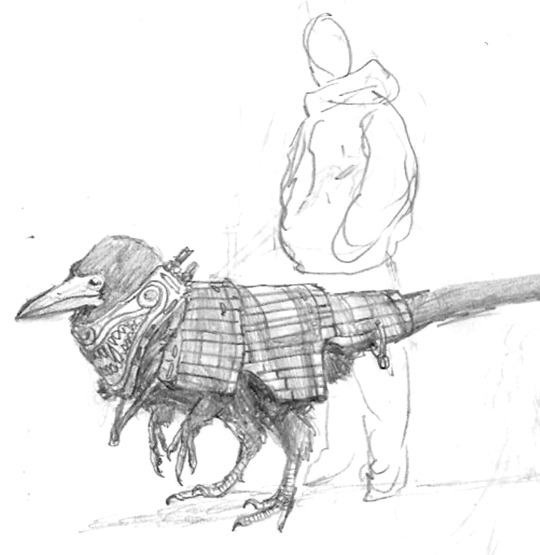
Studies for Avisapiens spear-throwers and wooden-slat armour; from a comparatively advanced period on this species’ societal development.

An A. saurotheos shaman entertains hatchlings with fireside tales of spirits and other worlds.

A band of slave-keeping A. tataricus warriors during a raid to an A. saurotheos village. A young shaman is captured and de-clawed.

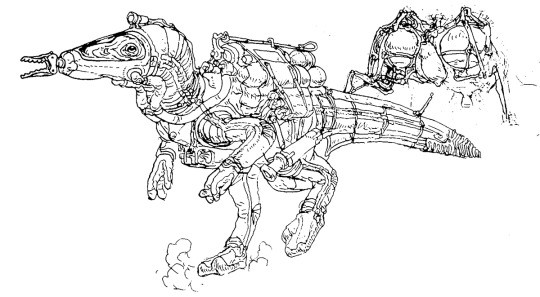

Simon Roy and I also dwelled on the far-future evolution of dinosauroid technology. The sketches above of a “knight”, moon lander and an astronaut were produced, but we did not pursue these scenarios seriously.

Let us conclude our visit to the dinosauroid tangent-universe with one last look at our artist/shaman, his village, and his paintings. Somewhere in deep time, they are still alive, and still waiting to tell us of their adventures.
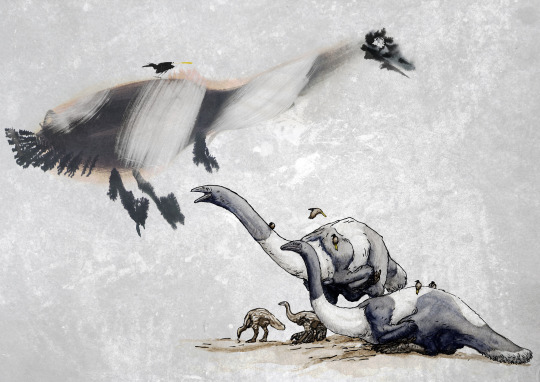
A painting of an avititan family.

A painting of the dangerous, predatory “black thing”.
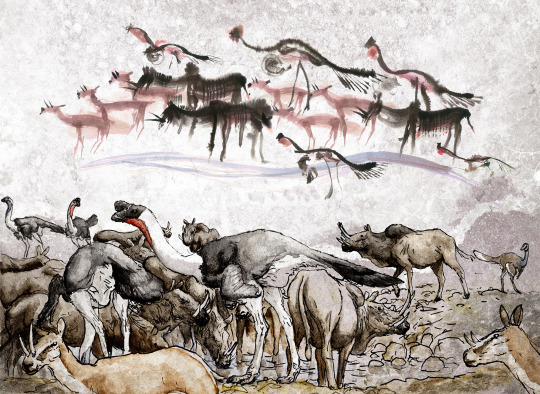
A painting showing numerous animals at a watering hole.

A painting showing an A. tataricus warrior.
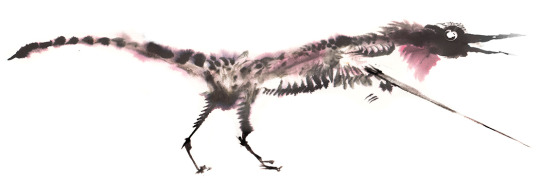

Stylised paintings of spear-wielding Carpathian warriors.

Painting of a ferocious Aegean headhunter.

A stylised painting showing an immature dinosauroid.

Stylised painting of a warrior confronting a spirit-creature.

Stylised painting of a powerful Caucausian mountain warrior.

Painting showing a ghoul-like oviraptoriform animal.

Painting of one of the sky-gods worshipped by A. saurotheos.
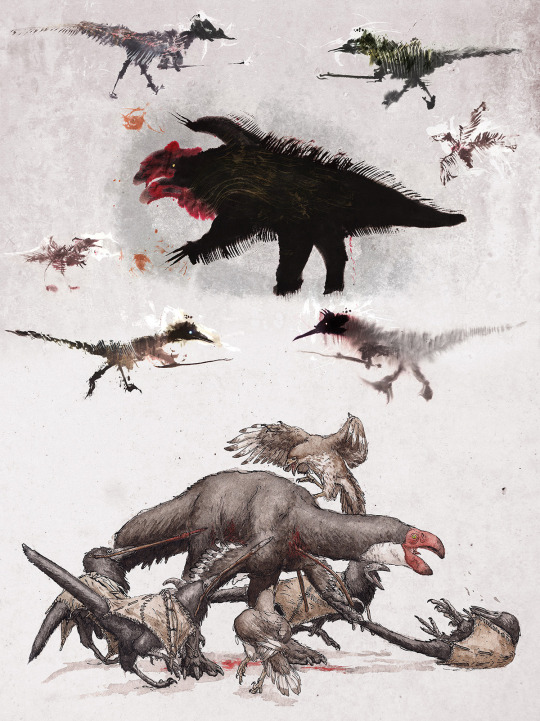
A complex painting showing four A. tataricus warriors hunting a bull Bosornithoides.
Simon Roy and I may return to the dinosauroids universe one day with a real story; but truth be told we enjoyed world-building far more than inventing stories and characters.
- 2008 - 10/2019.
#worldbuilding#speculative biology#speculative evolution#dinosaurs#dinosaur art#dinosauroids#paleoart#creature design#c m kosemen#simon roy
431 notes
·
View notes
Photo

(Note: I am not a professional paleontologist or even biologist. I am just and amateur paleoartist and enthusiast. If my infos are off in some way, feel free to correct them ^^)
-
DINOCEMBER
14 (Front) - Santanaraptor placidus (from the Latin "Thief of Santana")
15 (Back) - Aratasaurus museunacionali (combination of Tupi "ara" and "atá" and Greek "sauros" as "lizard born from fire")
- Early Cretaceous (112-108 Ma BCE)
- Romulado Formation, Ceara, Brazil
Probably one of the most famous Brazilian dinosaurs, the Santanaraptor is a member of the tyrannosauroid family, presenting more basal characteristics similar to the Asian Guanlong and Dilong, with long legs adapted for running, a trait common to most theropods of this lineage at the beginning of their walk to become massive predators, in the future using their powerful skulls and jaws as their main hunting weapon. The original Santanaraptor fossil, formally named in 1996, mainly featured the animal's back and legs, as well as soft tissue prints, such as muscle fibers and parts of the epidermis, with an estimated size for an adult individual at just under 2 meters, close the size of a velociraptor.
Also present on the great coastal plain at the same time as the Santanaraptor, the Aratasaurus was formally named in 2020, with its specific name honoring the National Museum of Brazil, unfortunately destroyed by the flames in 2018 resulting from years of neglect. The classification of Aratasaurus is still unclear, but it seems that it would also be a Coelurosaur, as well as Santanaraptor, part of the lineage that include birds and the most famous theropods, such as dromaeosaurs, tyrannosaurs and ornithomimosaurs. Aratasaurus seems to be more robust than Santanaraptor, about 3 meters long. I imagine that the two species would encouter themselves in life, like Aratasaurus perhaps acting similarly to a large spotted hyena while the agile Santanaraptor would be something like a coati or a mongoose, more of a opportunistic hunter.
- Color schemes based on a Northern Ground Hornbill (Bucorvus abyssinicus) for the Aratasaurus and a Madagascan Serpent Eagle (Eutriorchis astur) for the Santanaraptor.
#Araripe Basin#Romulado Formation#Brazil#dinocember#dinocember2020#santanaraptor#aratasaurus#aratasaurus museunacionali#Coelurosauria#brazilian dinosaurs#theropod#Tyrannosauroidea#saurischia#paleobiology#paleontology#paleoart#paleoillustration#Science illustration#sciart#cretaceous#south america#raptor#creature art#creature design#creature concept#Digital Artists#digital drawing#digital art#artists on tumblr
6 notes
·
View notes
Photo

ABYSSINIAN GROUND HORNBILL
Bucorvus abyssinicus
©Laura Quick
The Abyssinian ground hornbill or northern ground hornbill is an African bird, found north of the equator. There are two species of ground hornbill. Together they are the largest species of hornbills found in Africa.
Diurnal Abyssinian ground hornbills invest a lot in their offspring and the fledged juveniles will remain with their parents for up to three years. They have a slow breeding rate and an average of one chick is raised to adulthood every 9 years.
#abyssiniangroundhornbill#hornbill#bucorvusabyssinicus#©lauraquick#bird#animal#birds of tumblr#snakekiller#losangeleszooandbotanicalgardens#lazoo#losangeleszoo#glaza#africa#north of the equator#bucerotiformes#bucorvidae#ethiopia#eretria
15 notes
·
View notes
Photo

ABYSSINIAN GROUND HORNBILL wrassling a rubber coral snake Bucorvus abyssinicus ©Laura Quick The Abyssinian ground hornbill or northern ground hornbill is an African bird, found north of the equator, and is one of two species of ground hornbill. The two are the largest species of hornbills found in Africa. The Abyssinian ground hornbill has long feathers that look like eyelashes that surround its eyes. These protect the eyes from injury, and blowing dust or sand. In captivity, they can live up to 35–40 years. Diet in the wild consists of a wide variety of small vertebrates and invertebrates, including tortoises, lizards, snakes, birds, spiders, beetles, and caterpillars; they also take carrion, some fruits, seeds, and groundnuts. It is currently thought that the ground hornbills, are almost exclusively carnivorous and lack the gular pouch that allows other, less closely related hornbills to store fruit. Groups of ground hornbills have territories of 2–100 square miles (5.2–259.0 km2). They are diurnal. Abyssinian ground hornbills invest a lot in their offspring and the fledged juveniles will remain with their parents for up to three years. They have a slow breeding rate and an average of one chick is raised to adulthood every 9 years so the adults' investment in each young bird raised is exceptionally high. #abyssiniangroundhornbill #hornbill #bucorvusabyssinicus #©lauraquick #bird #animal #birdsofinstagram #snakekiller #losangeleszooandbotanicalgardens #lazoo #losangeleszoo #glaza #africa #northofequator #bucerotiformes #bucorvidae https://www.instagram.com/p/B8u-ak2nKqq/?igshid=cxfrlk8rial5
#abyssiniangroundhornbill#hornbill#bucorvusabyssinicus#©lauraquick#bird#animal#birdsofinstagram#snakekiller#losangeleszooandbotanicalgardens#lazoo#losangeleszoo#glaza#africa#northofequator#bucerotiformes#bucorvidae
3 notes
·
View notes
Video
Southern Ground Hornbill, Maasai Mara by Ray in Manila
Via Flickr:
The southern ground hornbill (Bucorvus leadbeateri; formerly known as Bucorvus cafer), is one of two species of ground hornbill and is the largest species of hornbill. The other species of the genus Bucorvus is the Abyssinian ground hornbill, B. abyssinicus. The southern ground hornbill is characterized by black coloration and vivid red patches of bare skin on the face and throat (yellow in juvenile birds), which are generally believed to keep dust out of the birds eyes while they forage during the dry season. The white tips of the wings (primary feathers) seen in flight are another diagnostic characteristic. The beak is black and straight and presents a casque, more developed in males. Female southern ground hornbills are smaller and have violet-blue skin on their throats. Juveniles to six years old lack the prominent red pouch, but have a duller patch of grey in its place. Southern ground hornbills can be found from northern Namibia and Angola to northern South Africa and southern Zimbabwe to Burundi and Kenya. And Hawaii as they have escaped the Honolulu Zoo. They require a savanna habitat with large trees for nesting and dense but short grass for foraging. The southern ground hornbill is a vulnerable species, mainly confined to national reserves and national parks. They live in groups of 5 to 10 individuals including adults and juveniles. Often, neighbouring groups are engaged in aerial pursuits. They forage on the ground, where they feed on reptiles, frogs, snails, insects and mammals up to the size of hares. Southern ground hornbills very rarely drink: their range is limited at its western end by the lack of trees in which to build nests. Southern ground hornbill groups are very vocal: contact is made by calls in chorus which can usually be heard at distances of up to 3 kilometres (1.86 mi). The calls allow each group to maintain its territories, which must be as large as 100 square kilometres (40 sq mi) even in the best habitat. They are among the longest-lived of all birds, and the larger southern species is possibly the slowest-breeding (triennially) and longest-lived of all birds. en.wikipedia.org/wiki/Southern_ground_hornbill
#Kenya#Maasai Mara#Africa#Birds#bird#bird of prey#Animal#colourful#EOS 650D#EF-S55-250mm#Fauna#grass#Green#nature#National Park#natural world#Equator#wildlife#Wild#exotic#beak#head#portrait#eye#red#hornbill#southern ground hornbill#Safari#Savanna#Animalia
1 note
·
View note
Text
Upupa

Eurasian Hoopoe by Jaiprakashsingh, CC BY-SA 3.0
Etymology: Hoopoe
First Described By: Linnaeus, 1758
Classification: Dinosauromorpha, Dinosauriformes, Dracohors, Dinosauria, Saurischia, Eusaurischia, Theropoda, Neotheropoda, Averostra, Tetanurae, Orionides, Avetheropoda, Coelurosauria, Tyrannoraptora, Maniraptoromorpha, Maniraptoriformes, Maniraptora, Pennaraptora, Paraves, Eumaniraptora, Averaptora, Avialae, Euavialae, Avebrevicauda, Pygostaylia, Ornithothoraces, Euornithes, Ornithuromorpha, Ornithurae, Neornithes, Neognathae, Neoaves, Inopinaves, Telluraves, Afroaves, Coraciimorphae, Cavitaves, Eucavitaves, Picocoraciae, Bucerotiformes, Phoeniculidae, Upupidae
Referred Species: U. africana (African Hoopoe), U. antaios (Saint Helena Hoopoe), U. epops (Eurasian Hoopoe), U. marginata (Madagascan Hoopoe)
Status: Extinct - Extant, Least Concern
Time and Place: Between 12,000 years ago and today, in the Holocene of the Quaternary

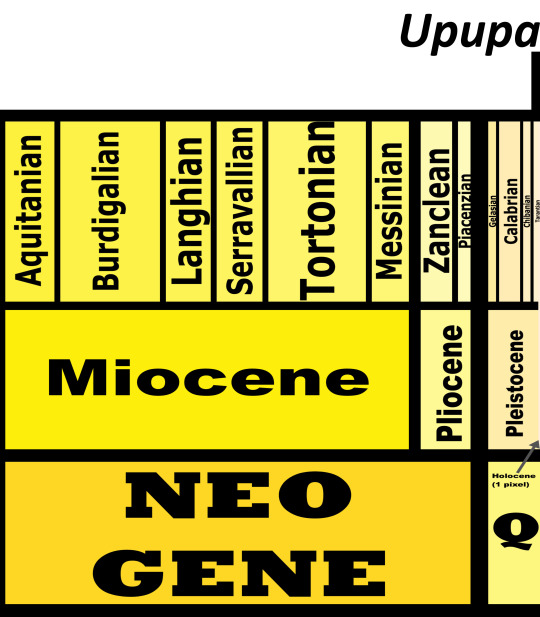
Hoopoes are known from all over the Eastern Hemisphere

Physical Description: Hoopoes are extremely distinctive birds! They have very long, thin, and curved bills that extend out greatly from their heads, and huge crests on their heads that are easily spotted. They have long, thin bodies, and feet built for perching. THeir wings are very square-ish, and they have shorter tails than other birds. However, their coloration is decidedly where they are most distinctive of all. They have bright orange heads, with orange crests - but the crests end in very slight white bandings and then black tips. Their bodies are orange, but their wings and rumps and tails are black and white striped all over! They are such beautiful, distinctive birds. The shades of orange can differ in brightness or redness based on species (for example, the African Hoopoe tends to be redder than the Eurasian Hoopoe), but they do tend to be overall similar to one another in appearance. Living species range between 19 and 32 centimeters long; the extinct Saint Helena Hoopoe, though it had smaller wings, probably could have reached 36 centimeters long.

Madagascan Hoopoe by Charles J. Sharp, CC BY-SA 4.0
Diet: Hoopoes primarily feed on insects, especially larvae, though some larger animals are also fed upon by these animals.
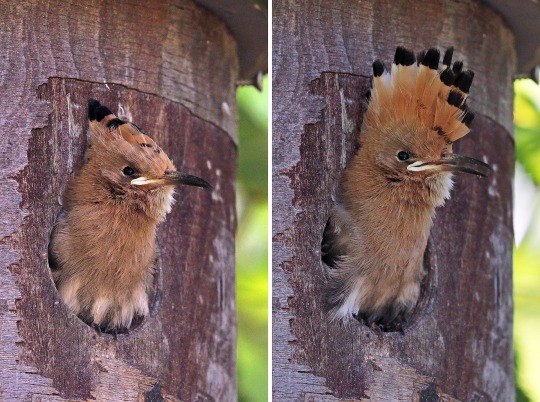
Common Hoopoe by Charles J. Sharp, CC BY-SA 4.0
Behavior: Hoopoes are very curious, adventurous birds, spending a lot of their time foraginging on the ground - they’ll dig with their bills into soft earth, using them to turn over leaves and probing into the mud and dung for insects and other invertebrates. They’ll even use their bills to prise off the bark from trees, or forage for insects in lichen! Sometimes, these birds also smash their food against the ground to They’ll usually forage in pairs or alone, spending a lot of their days looking for food. Some Hoopoes - especially the Madagascan Hoopoe - will forage in even slightly larger groups, of up to six individuals. Fascinatingly, Hoopoes have their own version of Penicillin - Anting! They’ll find piles of ants and roll around in them, allowing the ants to cover their feathers. The ants then secret substances that will kill bacteria, fungi, and other insects - protecting the Hoopoe (and other birds that Ant) from illness! These birds also take dust and sand baths to clean themselves; they’ll also sunbathe by spreading out their wings and tail low to the ground and tilting their heads up!

Madagascan Hoopoe by Charles J. Sharp, CC By-SA 4.0
Hoopoes are distinctive in one very special way that lead to its name - their voice! They literally make calls that sounds like “hoo-poo-poo” and “hoop-oop hoop-oop” - leading to the name, Hoopoe, as well as the genus name, Upupa, and the species name of the Eurasian species, epops. Interestingly enough, the Madagascan Hoopoe does not make this sound - but rather, more cooing sounds, like doves. These birds will also make harsh, scolding calls, trills, and hisses, depending on the situation. The females and males will communicate primarily in trilling sounds while watching out for their nests. These birds are often sedentary, not migrating over long distance, but northern populations usually do come south in the winter to avoid colder climates, creating a variety of populations with very distinctive seasons and migrational patterns from one another within the species.

Saint Helena Hoopoe by Apokryltaros, CC BY 2.5
Hoopoes are monogamous each breeding season (which varies throughout the year as Hoopoes live all over the Eastern Hemisphere), forming strong pair bonds (that only last for that period of time). Males make very frequent calls to establish their territories, and they often fight with each other very brutally - including stabbings that can leave their opponents blinded. Females will then mate with the winners of these contests, and together they make nests out of holes in trees and walls with very narrow entrances. They usually aren’t lined with much. The female then incubates the egg, while the male defends her and the nest. Clutch size tends to depend on location, varying between 4 and 12 eggs per nest. They are incubated for nearly three weeks. At hatching, the chicks are very white and fluffy after a few days, and the crest develops after two weeks. The chicks are able to leave the nest after about a month, though they still stick with their families for a little while. Sometimes, when males defeat each other and replace each other in the mated pair, they will kill the offspring of the replaced male. Females can produce foul-smelling liquid, as do the babies, to protect themselves from predators - since they smell like rotting meat, they can fend off meat-eaters and parasites, and potentially fend off bacteria. Chicks in the nests also are able to literally poop at intruders, helping them to protect themselves! After leaving the nest, they stay with the parents for another week as they gain their bearings; they then become sexually mature between ages one and two.

Eurasian Hoopoe by Frank Vassen, CC By 2.0
Ecosystem: Hoopoes live mainly in open country - pastures, orchards, steppe, dry savanna, wooded savanna, short grassland, and bare ground. They congregate near scattered, isolated trees for their roosting and nesting. They do need perches and shade, but they want the trees they get these services from to be rare in the environments - so they can go down to the ground to get their food! They are fed upon by herons, falcons, and many other birds of prey.

African Hoopoe by Derek Keats, CC BY 2.0
Other: Most hoopoes are not currently threatened with extinction - they are extremely common, widespread birds, that are even protected in many localities (being highly venerated in many cultures - it’s even mentioned extensively in the Quaran - and made the national bird of Israel; it is also considered a pest controller and thus is protected on that front also. Some local populations, such as those in Morocco, are more threatened due to local practices (such as selling them for medicine), but overall they seem to be doing well. In fact, there are probably as many as 10 million Hoopoe around today, if not more. Still, in more northern countries such as Germany they are more endangered, primarily due to changes in habitat, hunting, and human activity giving pressure to the populations. The numbers in Madagascar are slightly vulnerable too, given forest clearance. Hoopoes are closely related to the Hornbills!
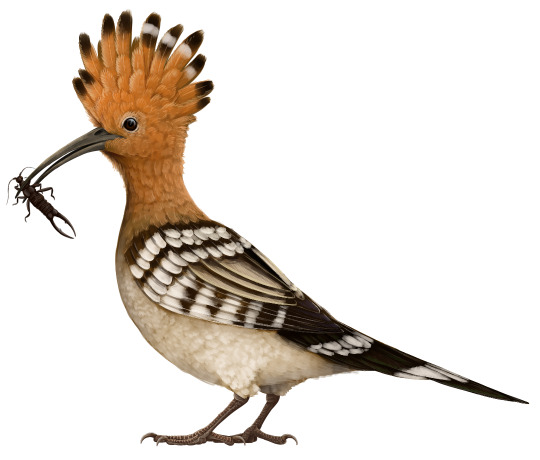
Saint Helena Hoopoe by Scott Reid
Species Differences: The four species primarily differ based on location: The African Hoopoe is found in Africa; the Eurasian Hoopoe is found in Eurasia; the Madagascan Hoopoe is known from Madgascar: and the late Saint Helena Hoopoe - now extinct - was known from the island of Saint Helena off the coast of Africa! The Saint Helena Hoopoe differed from the other species in other ways, too - it had smaller wings, was somewhat larger, and was probably flightless! A giant flightless Hoopoe! And, like most large flightless birds of the recent past, it went extinct due to human activity on the island - this time, sometime in the 1500s.
~ By Meig Dickson
Sources Under the Cut
Ashmole, N. P. 1963. The extinct avifauna of St. Helena Island. Ibis 103b:390-408
Burney, D. A., N. Vasey, L. R. Godfrey, Ramilisonina, W. L. Jungers, M. Ramarolahy, and L. Raharivony. 2008. New findings at Andrahomana Cave, southeastern Madagascar. Journal of Cave and Karst Studies 70(1):13-24
Carroll, R. L. 1988. Vertebrate Paleontology and Evolution 1-698
Clements, J. F., T. S. Schulenberg, M. J. Iliff, D. Roberson, T. A. Fredericks, B. L. Sullivan, and C. L. Wood. 2017. The eBird/Clements checklist of birds of the world: v2017
del Hoyo, J., Collar, N. & Kirwan, G.M. (2019). Madagascar Hoopoe (Upupa marginata). In: del Hoyo, J., Elliott, A., Sargatal, J., Christie, D.A. & de Juana, E. (eds.). Handbook of the Birds of the World Alive. Lynx Edicions, Barcelona.
Goodman, S. M., M. J. Raherilalao, and K. Muldoon. 2013. Bird fossils from Ankilitelo Cave: inference about Holocene environmental changes in southwestern Madagascar. Zootaxa 3750:534-548
Kri?tín, A. & Kirwan, G.M. (2019). Common Hoopoe (Upupa epops). In: del Hoyo, J., Elliott, A., Sargatal, J., Christie, D.A. & de Juana, E. (eds.). Handbook of the Birds of the World Alive. Lynx Edicions, Barcelona.
Linnaeus, C. 1758. Systema Naturae per Regna Tria Naturae, Secundum Classes, Ordines, Genera, Species, cum Characteribus, Differentiis, Synonymis, Locis. Editio Decima 1:1-824
Olson, S. L. 1975. Paleornithology of St. Helena Island, South Atlantic Ocean. Smithsonian Contributions to Paleobiology 23:1-49
Sinclair, Ian; Ryan, Peter (2009). Complete Photographic Field Guide: Birds of Southern Africa. Struik Nature.
#Upupa#Hoopoe#Bird#Dinosaur#Upupa epops#Afroavian#Factfile#Insectivore#Flying Friday#Quaternary#Africa#India & Madagascar#Eurasia#Birds#Palaeoblr#Birblr#Dinosaurs#Upupa africana#Upupa antaios#Upupa marginata#Madagascan Hoopoe#Common Hoopoe#Eurasian Hoopoe#African Hoopoe#Saint Helena Hoopoe#paleontology#prehistory#prehistoric life#biology#a dinosaur a day
207 notes
·
View notes
Photo

Also from the Maryland Zoo. I fell completely in love with the northern ground hornbill. He walked around his enclosure, looking at passersby and carrying a stone in his bill the entire time. #northerngroundhornbill #bucorvusabyssinicus #sciart #marylandzoo https://www.instagram.com/p/Bs6X_QQns7k/?utm_source=ig_tumblr_share&igshid=ko3sy1gz04ko
12 notes
·
View notes
